
BULLETIN
WINTER 2007 VOLUME 53
NUMBER 4
2@2
PLANT SCIENCE
ISSN 0032-0919
Editor: Marshall D. Sundberg
Department of Biological Sciences
Emporia State University
1200 Commercial Street, Emporia, KS 66801-5707
Telephone: 620-341-5605 Fax: 620-341-5607
Email: psb@botany.org
The Botanical Society of America: The Society for ALL Plant Biologists
Errata................................................................................................................................................138
Coastal Roots: A Pre-college Plant-based Stewardship Program to Connect Students
with Coastal Issues..........................................................................................................138
The Green World: Plants for Now and the Future......................................................................146
News from the Society
From the Office.................................................................................................................148
BSA Science Education News and Notes....................................................................149
Editor’s Choice.................................................................................................................151
A Call to Student Members............................................................................................152
Announcements
In Memoriam
Bertil Kullenberg (1913-2007).........................................................................152
Robert R. Nakamura (1954-2006)....................................................................153
Judith D. Zuk (1952-2007)...............................................................................154
Personalia
Dr. Peter Raven Receives Verril Medal from Peabody Museum..............155
Robert Allerton Award for Excellence in Tropical Botany or Horticulture
awarded to Dr. William R. Anderson............................................155
Rachel Carson Environmental Award to Dr. Michael J. Balick.................157
Kenneth G. Karol joins Staff at New York Botanical Garden....................157
State Department Names Dr. Nina V. Federoff New Science Advisor.....157
Symposia, Conferences, Meetings
The Fourth International Conference on the Comparative Biology of the
Monocotyledons and The Fifth International Symposium on
Grass Systematics and Evolution..................................................158
Positions Available
Seed Bank Technician at Chicago Botanic Garden....................................159
Senior Plant Scientist......................................................................................159
Curator of Botany, John T. Howell Curatorial Chair of Western North
American Botany at the California Academy of Sciences.........160
John J. Rose Postdoctoral Fellowship in Botany.......................................160
Manager, Conservation Training Programs, Chicago Botanic Garden...161
Courses/Workshops
Experience in Tropical Botany.......................................................................161
National Tropical Botanical Garden Fellowship for College Biology
Professors.........................................................................................162
The Kampong: An Excellent Site for Academic Conferences, Workshops
and Courses in Tropical Botany and Conservation...................162
Other
Rare Maps on Display at the Chicago Botanic Garden: Maps from the
Rare Book Collection of the Lenhardt Library............................163
Try Chia!...........................................................................................................163
The Vascular Plant Atlas of Georgia On-line...............................................163
continued on next page

138
Plant Science Bulletin 53(4) 2007
P
LANT
S
CIENCE
B
ULLETIN
POSTMASTER: Send address changes to:
Botanical Society of America
Business Office
P.O. Box 299
St. Louis, MO 63166-0299
E-mail: bsa-manager@botany.org
Address Editorial Matters (only) to:
Marsh Sundberg, Editor
Dept. Biol. Sci., Emporia State Univ.
1200 Commercial St.
Emporia, KS 66801-5057
Phone 620-341-5605
E-mail: psb@botany.org
ISSN 0032-0919
Published quarterly by Botanical Society of America, Inc., 4475 Castleman Avenue, St. Louis,
MO 63166-0299. The yearly subscription rate of $15 is included in the membership dues of
the Botanical Society of America, Inc. Periodical postage paid at St. Louis,MO and additional
mailing office.
Errata
It seems that the publishing equivalent of a
transposable element slipped into Lee Kass’ paper,
“Landmarks and Milestones in American Plant
Biology: The Cornell Connection,” in the last issue
and deleted individual letters in a number of words.
Corrections include: on page 92, “More Notable
Botany Departments” section. relevant replaces
releant; Director replaces Diretr, 1913 replaces
113, and replaces an, professorships replaces
proessorships.- - bottom of page 95, last paragraph
on left; after replaces ater, and Wellesley replaces
ellesley. A corrected PDF copy has been placed on
the web page.
This issue has a little bit of education for everybody!
Two years ago Katrina hit the Gulf Coast and
suddenly the entire country began to learn about the
role of wetlands and wetland loss in South Louisiana.
Of course, this is something the natives have known
for years. In our first feature we learn about a
program, run out of LSU since pre-Katrina, that has
school groups growing and transplanting wetland
plants to “reroot” coastal Louisiana.
Our second article takes us to the west coast where
non-science students at UCLA get some “hands
on”, “whole plant” biology in the Molecular, Cell, and
Developmental Biology Department. “The Green
World” provides students with a little bit of the old and
a little bit of the new in a format that provides them
an awareness of what can be found in the produce
section of the local supermarket.
-The Editor
Also, in the review of Rice’s “Encyclopedia of
Evolution,” the reviewer’s citation of “Gone with the
Wind” should have been “Inherit the Wind.”
Coastal Roots:
A Pre-college Plant-based
Stewardship Program to
Connect Students with Coastal
Issues
Abstract
The LSU Coastal Roots Program is a sustained
pre-college plant-based stewardship program in
which students grow native plants in their school-
based plant nursery that they will later transplant on
a habitat restoration trip. The program integrates
both plant and earth science content within the
context of a real-world problem, i.e., coastal land
and habitat loss in Louisiana, and was initiated to
provide a students an opportunity learn about these
important issues and have a hand in taking positive
actions to preserve and rebuild our coast. Operating
in 18 public and private schools in southern
Louisiana since 2000, the program has brought
nearly 2,000 precollege students (grades 4-12) on
57 restoration trips to plant about 18,000 student-
grown plants. Students are involved in every phase
of the program, from installing the automatic
irrigation system and nursery yard at the start of the
program, to planting seeds and propagating
grasses, and finally transplanting the seedlings at
their long-term partner’s restoration site.
Key Words
stewardship, environmental science, pre-college,
responsible citizenship, horticulture, habitat restoration
DNA Inventory of the New York Botanical Garden’s Forest Demonstrates
Effectiveness of DNA Barcoding as Identification Tool...........................164
Books Reviewed...............................................................................................................................165
Books Received................................................................................................................................179
BSA Contact Information................................................................................................................179
Botany 2008.......................................................................................................................................180
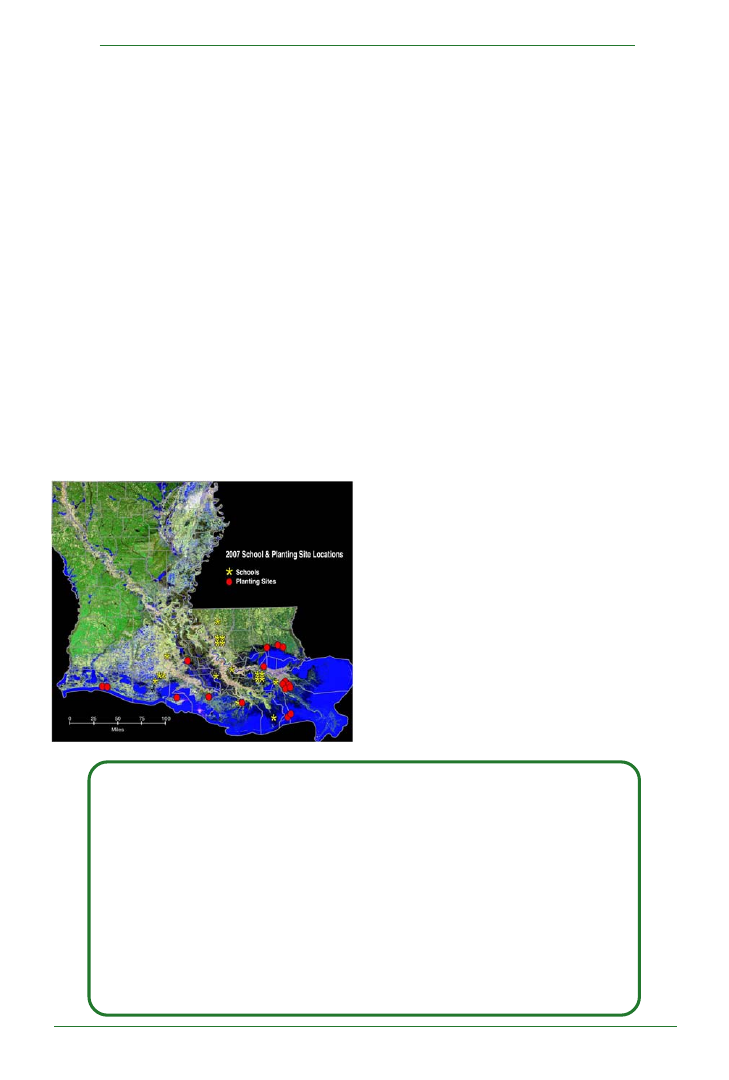
139
Plant Science Bulletin 53(4) 2007
Editorial Committee for Volume 53
Joanne M. Sharpe (2009)
Coastal Maine Botanical Gardens
P.O. Box 234
Boothbay, ME 04537
joannesharpe@email.com
Nina L. Baghai-Riding (2010)
Division of Biological and Physical Sciences
Delta State University
Cleveland, MS 38677
nbaghai@deltastate.edu
P
LANT
S
CIENCE
B
ULLETIN
Andrea D. Wolfe
(2007)
Department of EEOB
1735 Neil Ave., OSU
Columbus, OH 43210-1293
wolfe.205@osu.edu
Samuel Hammer (2008)
College of General Studies
Boston University
Boston, MA 02215
cladonia@bu.edu
Jenny Archibald (2011)
Department of Ecology and Evolutionary Biology
The University of Kansas
Lawrence, Kansas 66045
jkarch@ku.edu
Rationale for the Program
A. Educational Place of Stewardship Projects
The Coastal Roots Program is a sustained pre-
college plant-based stewardship program in which
students grow native restoration plants in their
school plant nursery that they will later transplant in
a habitat restoration trip. The program grew out a
need to inform students about important issues
affecting Louisiana’s coastal resources. In 1999,
the Louisiana Sea Grant College Program’s
educational coordinator (the author of this paper)
met with LSU wetland and fisheries specialists to
discuss how to unite independent efforts to help
students grow restoration seedlings into a single
project. With the help of a LSU College of Agriculture
horticulture professor the group began assembling
an outreach program that combined the learning of
geological and horticultural science with information
on critical coastal issues in a hands-on stewardship
project involving student-grown and transplanted
native plants. The LSU Coastal Root (CR) Program
was born. Today, the CR Program currently operates
in 18 schools in ten parishes (counties).
Participating classes are from grades 4-12 and
from both public and private schools. School
involvement takes many forms, from formal science
classes to extracurricular environmental and science
clubs to agriscience classes.
B. Louisiana’s Situation
Louisiana is losing its coastal land at an alarming
rate. Between 1978 and 2000, Louisiana lost 658
square miles (1,704 square kilometers) of land,
representing almost half the land area of the state
of Rhode Island, with an annual loss rate for this
period at nearly 30 square miles (77.4 square
kilometers) per year. Future land loss (2000-2050),
with consideration for existing restoration projects
and diversions, is projected to be 513 square miles
(1329 square kilometers), with an annual loss rate
of 10.26 square miles (26.6 square kilometers) per
year (Barras, et al, 2003).
Land change in Louisiana is the result of a number
of both natural and human impacts (Louisiana
Coastal Wetlands Conservation and Restoration
Task Force, 2003). The leveeing of the Mississippi
River reduced and mostly eliminated the
replenishment of sediment to the marshes and
instead shuttled these sediments into the Gulf of
Mexico. Furthermore, the levees served to shuttle
the sediment load of the Mississippi River into the
deep waters of the Gulf of Mexico, rather than the
natural distribution and replenishment that had been
in place through a myriad of distributaries into the
coastal marshes. The natural subsidence of old
Mississippi River delta sediments also accounts for
some of the land change. Other impacts include salt
water intrusion, herbivo ry (e.g., by invasive species
- nutria, Myocastor coypus), alterations to the natural
hydrology of coastal wetland systems, storm
impacts, dam building up-river, oil and gas
exploration and canal dredging, and harvesting of
wetland forests. Most recently, hurricanes Katrina
and Rita in 2005 resulted in an estimated land loss
of 217 square miles (526 square kilometers) (Barras,
2006). These two storm events represent nearly half
of the projected net land loss for 2000-2050.
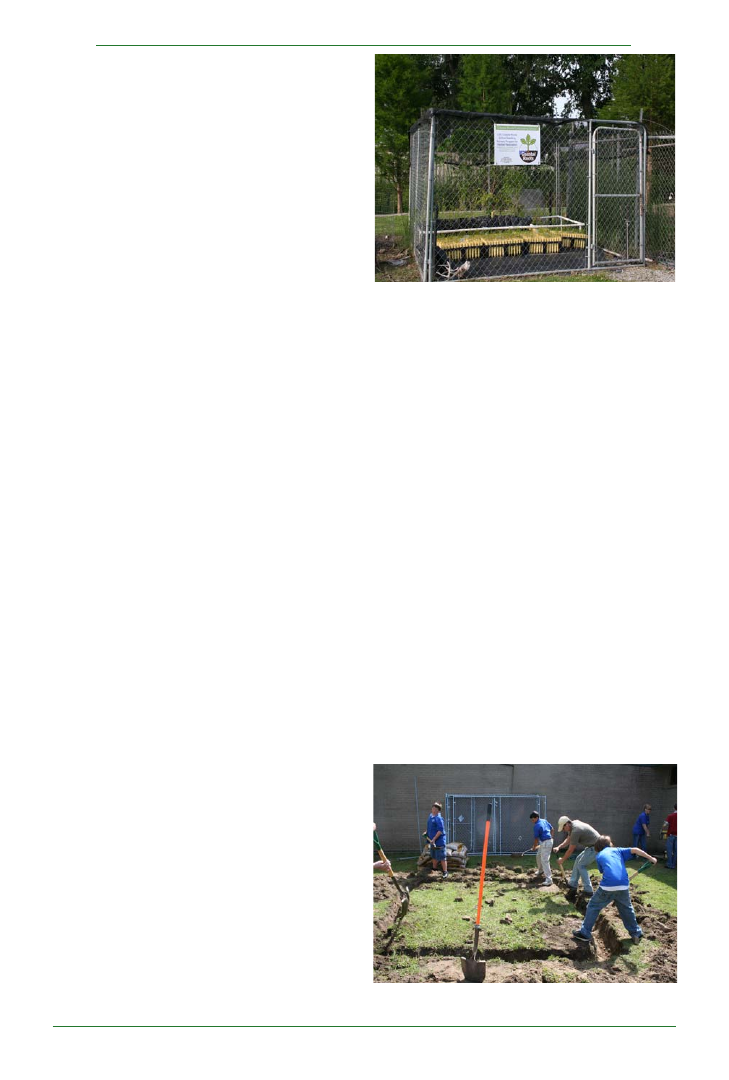
140
Plant Science Bulletin 53(4) 2007
The coastal land loss in Louisiana has serious
state and national economic ramifications.
Louisiana is the largest producer of shrimp, oysters
and blue crab, with a fisheries industry valued at
over $2.85 billion. Over 40,000 residents earn their
livings through work related to the wetlands or in the
fisheries industry. Louisiana brought in more than
$10 billion dollars during 2004 (pre-Katrina) in the
tourism industry. In terms of oil and gas, Louisiana
ranks first in crude oil production and second in total
energy production, natural gas production,
petrochemical production, and refining capacity.
The oil and gas industry employs more than 42,000
men and women at a cost of $2.7 billion dollars.
Sugar cane, an agricultural crop found mostly along
the coastal plain has an annual economic impact
of $1.7 billion dollars (Bourque, 2007). Despite the
obvious value of these commodities to the nation,
convincing the nation to invest in saving these
fragile coastal lands has been a long and arduous
process.
Given the coastal land loss crisis and the importance
of these lands to the economic well-being of both
Louisiana citizens and the nation, the Coast 2050
Executive Summary (Louisiana Coastal Wetlands
Conservation and Restoration Task Force, 1998)
gives a clear call to action, “Stewardship requires
us to care for and nurture what we have and what we
are given. For the coast of Louisiana to survive, we
must change the way we do business” (p. 11). The
CR Program was initiated to provide a sustained
hands-on school-based stewardship activity that
offers students an opportunity learn about these
important issues and have a hand in taking positive
actions to preserve and rebuild our coast.
Structure of the CR Program
The primary goal of the CR Program is to assist
students in developing an attitude of stewardship
toward our natural resources and to provide an
active learning situation in which they can explore
strategies for sustaining our coastal habitats. Three
objectives align with this goal: (a) to conduct an on-
going school-based nursery program involving the
growing and restorative transplanting of native
plants, (b) to develop in students an attitude of
stewardship toward natural resources, and (c) to
provide teachers and students with instruction on
relevant issues such as ecological stewardship,
wetlands functions and values, habitat restoration
and conservation, as well as basic geology and
horticulture skills.
The program components were developed based
on a desire to make the program both as hands-on
as possible and as meaningfully integrated into
school subjects as possible. The program
components include school-based plant nurseries,
restoration planting trips, teacher professional
development, and supporting program materials.
The CR Program involves a one-time start-up
expense of about $1,250 for the can yard and
irrigation system materials. Annual expenses of
about $200-300 cover materials such as planting
media, fertilizer, seeds, and miscellaneous
gardening supplies. The annual restoration trip
generally costs about $300-500, and includes the
cost of the school bus(es), substitute teacher, drinks
and snacks, and miscellaneous equipment.
School-based plant nurseries
When schools join the program, the first task is to
have the students help install their plant nursery,
which is contained within a 10’x10’ area on school
property. This involves digging trenches for irrigation
lines, helping to assemble the irrigation system,
installing gravel and a groundcover cloth, and
assembling a dog kennel to keep stray dogs, balls
and children out of the nursery area (Coleman and
Bush, 2002; Bush and Blanchard, submitted). An
automatic irrigation timer is fitted into the system to
facilitate daily watering, as well as watering over
school holidays and summer vacations. The teacher
A finished LSU Coastal Roots can yard. One year old
cypress seedlings are in the yellow cells; two-year old
cypress and wax myrtle are in the black one gallon tree
pots.
Middle school students help LSU Coastal Roots staff
dig the trench for the irrigation system.
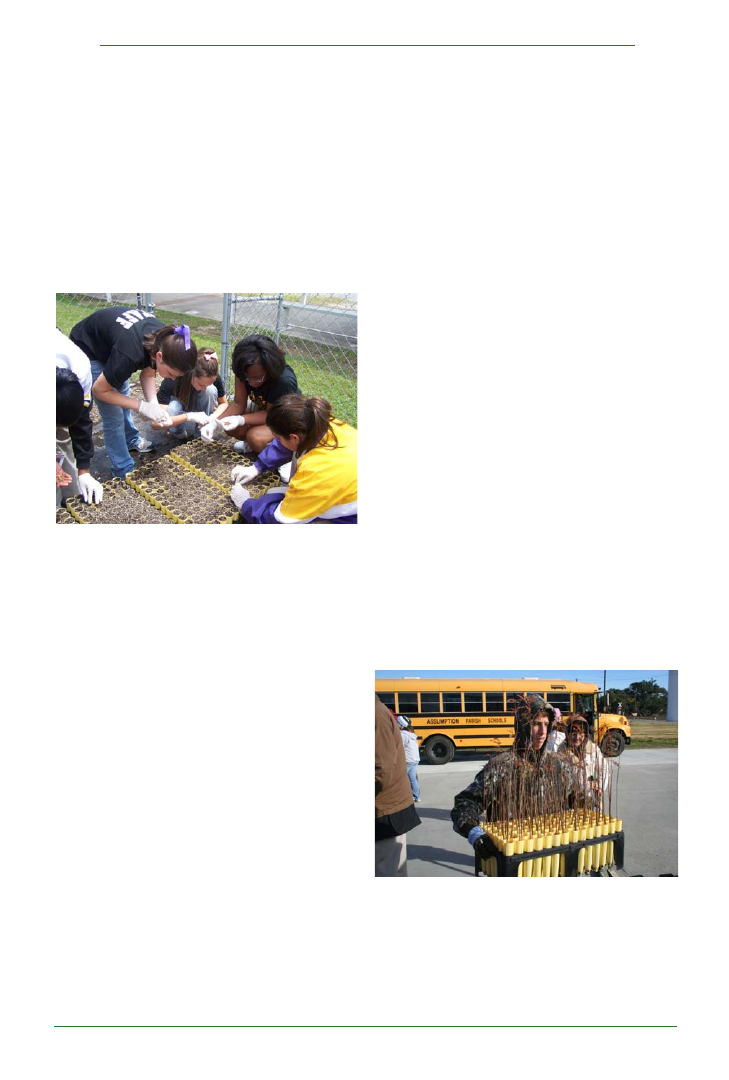
141
Plant Science Bulletin 53(4) 2007
and school staff check the irrigation system once or
twice a week during the summer to insure that it is
working properly and that the plants are receiving
sufficient irrigation.
In the early spring, students clean and sterilize
reusable plant cells and trays using bottle brushes
and a mild soap/bleach solution. Then they plant
their seeds in the plant cells filled with planting
media. Each plant nursery is outfitted with 980 plant
cells that are held in 10 trays. These trays are placed
in the plant nursery and students monitor the
germination of their plants. After about a month,
students begin adding small amounts of fertilizer to
the cells to enhance plant growth. In the fall, the
students continue to monitor seedling growth, pull
weeds, and fertilize the plants on a monthly basis
until it is time to transplant them in their new habitat.
In 2006-7, each school was partnered with a long-
term restoration site. Restoration sites range from
state parks, hurricane protection levees, city parks,
conservation areas, wildlife refuges, to private
property. The restoration site partners agree to
allow students to access their property in order to
transplant their seedlings, to monitor and help
sustain the newly transplanted seedlings, and to
help the partner school teacher and students
understand the need for the particular seedlings
that were requested by the restoration site manager.
The current list of native plants growing in the CR
Program school nurseries includes black mangrove
(Avicennia nitida), bitter panicum (Panicum
amarum), ?southern waxmyrtle (Myrica cerifera),
?hackberry (Celtis laevigata), ?smooth cord grass
(Spartina alterniflora), ?southern baldcypress
(Taxodium distichum), ?live oak (Quercus
virginiana), ?long leaf pine (Pinus palustris), ?loblolly
pine (Pinus taeda), and ?swamp red maple (Acer
rubrum). Since Louisiana is in one of the main
migratory bird flyways in the United States, many of
the chosen seedlings fulfill specific food or habitat
needs of some of the migratory bird species.
Ultimately, the goal for the restoration partnership
is for the teacher and students at the school to
communicate with the site manager on a regular
basis so that they can jointly determine what species
of seedlings would best fill the needs at the site in
the coming year.
As students ready for their transplant trip in the fall,
they will retain about 200-250 trees in their school
nursery. These selected seedlings will be “bumped
up,” or transplanted, into one-gallon tree pots and
grown in the school nursery for an additional year.
This extra year of nursery growth ensures a stouter
seedling for transplanting the next year – one that
will better withstand the rigors of growing in the wild.
Thus, after the first year in the program, most schools
are transplanting about 300 one-year-old seedlings
and 200-250 two-year old seedlings on their fall
restoration trip.
Plantings at partner restoration sites
Once a year, generally in the fall or early winter,
students transplant the plants they have grown to
their partner restoration site. This restoration
planting trip generally lasts a full school day,
sometimes longer, depending on the distance
students have to travel to get to the transplant site.
When students arrive at the restoration site, they are
instructed about how to properly plant their
seedlings, including how to use a dibble and fertilize
their seedlings. Students are divided into planting
teams, given a bag of slow-release fertilizer and a
shovel or dibble, and are sent off to plant their
seedlings. In addition, some teachers have students
collect data on their newly transplanted seedlings,
such as seedling diameter, height, and GPS
coordinates. In areas with large populations of
nutria and beaver, students install plant protectors
to help guard small seedlings. Some restoration
sites physically mark areas where seedlings need
to be planted with flags, others have personnel on
hand to direct the student planting teams. While
Environmental club students planting cypress seeds.
A middle school student unloadfing one-year old
cypress seedlings at a restoration site.
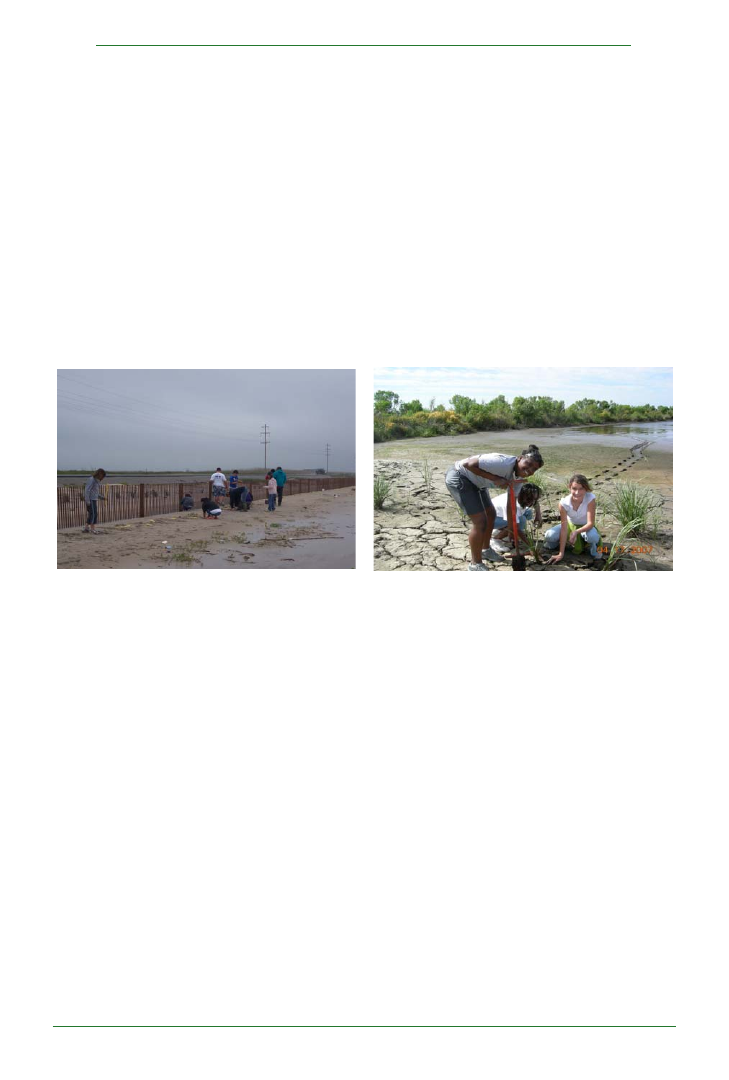
142
Plant Science Bulletin 53(4) 2007
most of the plants are grown by the students, CR
Program students have also helped plant seedlings
donated by landowners, the LSU AgCenter, as well
as seedlings purchased through school grants.
Part of the planting experience is a tour of the
restoration site to learn from the site manager why
the site needs assistance and how the specific
plants transplanted that day will help restore the
habitat at the site. Some of the many ways the
student-grown seedlings benefit their planting site
partners include helping to stabilizing levees,
reforesting wetland preserves and damaged areas
from runoff and construction, beautifying areas,
replacing invasive vegetation with native plants,
reclaiming wetlands that have been drained for
agriculture or crawfish ponds, and providing food
resources and nesting habitat to local and migratory
wildlife species.
CR Program seedlings have been transplanted in
a variety of habitats, including salt marsh, swamp,
bottomland hardwood forests, bayou banks, and
levees. These habitats can be found in a variety of
locations, such as hurricane protection levees,
state parks, National Wildlife Refuges, nature
preserves, private lands, botanical gardens,
wetlands reserves, boat landings, local parks, and
zoos.
Supporting CR Program Materials
Information necessary to successfully carry out this
type of stewardship program with students is not
typically found in text books, and thus, it quickly
became apparent that teachers would need access
to a wide variety of supporting program materials.
These materials range from lesson plans, to a
handbook on installing and running a school-based
nursery (Coleman and Bush, 2002), fact sheets
about plants and specific coastal issues, as well as
a multitude of “how-to” information sheets ranging
from how to set the irrigation timer to how to bump
up one-year-old seedlings. The most expedient
and economical way to distribute these materials is
via a website.
The LSU Coastal Roots website (
http://
calvin.ednet.lsu.edu/~coastalroots/
) accomplishes
a number of important tasks. It is one of the primary
means of communication with the teachers,
students, and families participating in the project
and serves as a source of information for those
interested in becoming affiliated with the program.
The website makes available a list of current
schools, a newsletter archive, nursery instructions
(e.g., seed preparation and nursery production, fact
sheets on selected plants, can yard and cold frame
information), teacher information (e.g., grant
possibilities and information on the Louisiana
Wetland Education Coalition listserve), event
calendar, helping hands (acknowledgements of
individuals and organizations that have helped the
program and individual schools be successful),
newsflashes (copies of newspaper articles about
school accomplishments in the program) and
lesson plans. Occasionally, teachers will have
students produce PowerPoint presentations on
topics that are of use to others in the CR Program.
These student-produced materials are also posted
on the website and are testimony to some of the
learning outcomes these students are taking with
them by participating in the program.
Coleman and Bush, in Putting Down Roots (2002),
introduced the concept of stewardship restoration
projects, described the basic decisions that have to
be made (including funding sources, what to plant,
and where to get seeds), how to build a school
nursery (with complete instructions and photos),
how to grow and care for seedlings, and how to
transplant seedlings at a restoration site. New
teachers entering the program are given a copy of
this short handbook to help explain what will happen
as they progress through the program.
Standards-based lessons and activities are
available for teachers to integrate the CR Program
with the science concepts required by the state
science curriculum. The lessons strive to be hands-
Middle school students planting bitter panicum along a
badly eroded beach in Cameron Parish
Middle school students planting Spartina alterniflora on
a hurricane protection levee in Terrebonne Parish
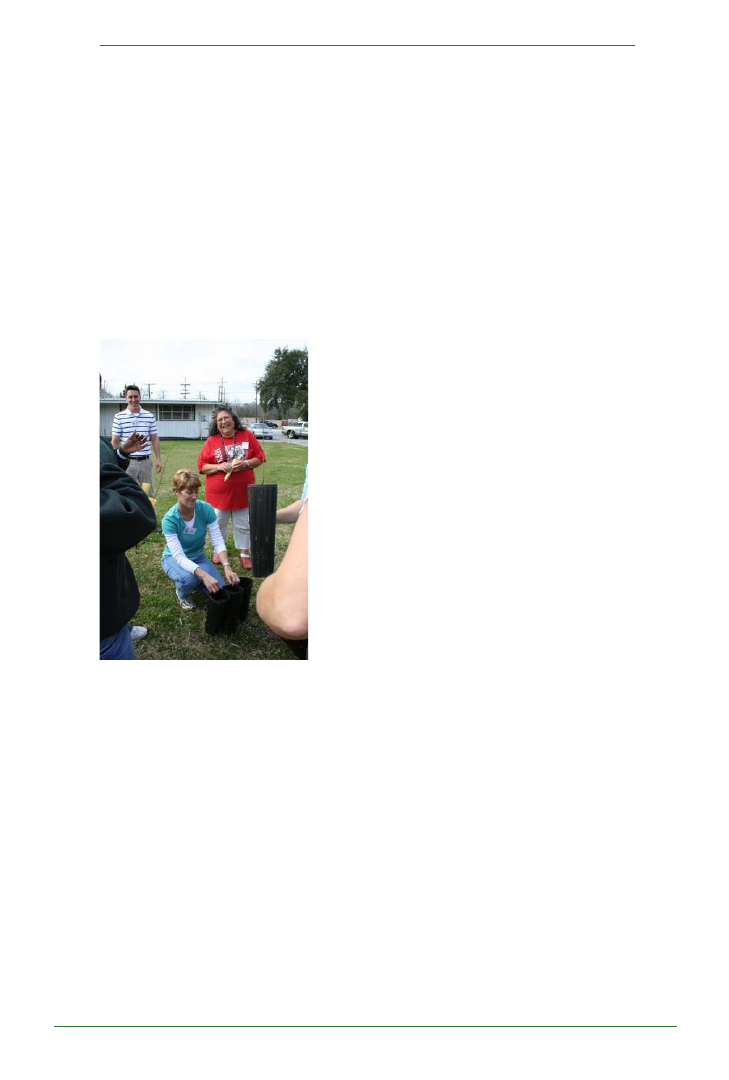
143
Plant Science Bulletin 53(4) 2007
.
on and cover issues about wetlands and coastal
restoration (typically found in middle and high school
earth science courses, as well as high school
environmental science courses) and horticulture
(typically found in middle school life science courses,
as well as high school biology courses). These
lessons are posted on the CR Program website
(URL above).
Teacher Support
Teachers have many responsibilities, especially in
light of the high stakes accountability environment
currently in place in the United States. Thus the
program resources discussed above are critical
support components if the participating schools
are to be successful in the program. The most
successful schools in the CR Program have full
support of their administrative staff and usually
more than one teacher involved in the program.
Each year, two professional development
workshops are organized for the participating
teachers. The summer institute is two days in
length and is held immediately after school is
dismissed for the summer. This workshop covers
critical issues such as the current status of land
loss in Louisiana and how to help students manage
a successful seedling nursery. The institute includes
a number of fieldtrips to highlight specific issues
that are discussed during the workshop, such as
land loss and restoration efforts. Hands-on training
is also an important component of this workshop
and includes activities such as on how to
troubleshoot irrigation timers or bump up one-year-
old seedlings. Perhaps most importantly, teachers
have time to talk and share with one other how they
integrate the CR Program into their existing courses.
Institute staff have found that these formal and
informal exchanges allow teachers to teach each
other how to run a successful program. A second
professional development workshop occurs in mid-
January. At this one-day Saturday workshop,
participating schools share updates on their
nurseries, lessons and nursery management ideas,
and pick up planting media and seeds for their
spring seed planting.
Technical Support
Technical support is key in helping the teachers
successfully manage their school programs and
begins with the can yard installation at the school.
It continues throughout the program in the form of
troubleshooting of plant and irrigation system
problems, which includes posting useful
information on the program website as well as
monthly visits by program staff to the schools to
ensure that the seedling nursery is weed-, pest-,
and irrigation-trouble free. CR Program staff also
help facilitate the conversation between the teacher
and the long-term planting site manager with regard
to the plant selection and transplanting trip details.
Staff often accompanies the schools on their
restoration field trips, and the program loans out
shovels, dibbles and other transplanting tools for
these field trips. CR Program personnel write all the
program information that is posted on the website
and edit teacher-written lessons for science content
accuracy and pedagogical content. Another aspect
of the technical support is securing ongoing funding
for the program. Grant writing is an important function
provided by the CR Program staff. More than
$175,000 in funded grants since 2000 has
supported the program. Staff also assist interested
teachers in learning how to write grants to support
their individual nursery programs.
Project communication is as important as technical
support. Project communication includes
newsletters, school visits by Coastal Roots staff,
and emails. Newsletters are written by Coastal
Roots personnel four to five times over the school
year and include timely reminders of information
teachers need in order to successfully help students
manage their plant nurseries. Also featured are
school nursery news articles, which are often written
by student authors that describe recent events the
schools have participated in. The newsletters
contain photos from the events and are a way of
encouraging schools to communicate with CR
Program staff about their accomplishments with
the program. Newsletters are sent by mail to
teachers, principals, superintendents and
supporters of the program. They are also sent by
email as PDF files to teachers and principals and
are posted on the CR Program website for public
viewing. As mentioned previously, monthly school
visits are made by program staff, with the purpose
Two teachers”bumping up” one year old cypress
seedlings into gallon tall pots.

144
Plant Science Bulletin 53(4) 2007
of accomplishing two objectives: (1) make sure that
the can yard is operating properly and that there are
no visible problems, and (2) provide a face-to-face
opportunity for the teacher to ask any questions they
might have about the program.
Research
Two LSU Master’s theses, one in horticulture (Karsh,
2004) and one in education (Somers, 2004), have
been based on the CR Program. Ongoing research
is being conducted by this author on the nature and
value of stewardship projects.
Benefits of Fostering Stewardship
The CR Program combines science with hands-on
opportunities to make a difference. Students in this
program learn science by actually doing science.
They use plant biology, botany, math and geology
skills, and also learn about how the culture of south
Louisiana is intertwined with and tied to the spaces
and places of the coast. Students take ownership
of their nurseries, participate in a restoration planting
trip that benefits not only themselves but the broader
community, and come to realize that they too can
make a positive difference. They have the satisfaction
and pleasure of seeing the products of their labor
being put to good use.
Teachers participate in the CR Program for a variety
of reasons. Some participate because it makes
learning science and math relevant and connects
these subjects to serious current issues in
Louisiana. It provides a way to integrate a variety of
subjects, including math, science, history, civics
and geography. The technical support is helpful and
the teachers are not left to fend for themselves when
it comes to troubleshooting problems or figuring out
the best way to teach a particular point. In addition,
they can take their students on a restoration planting
trip that emphasizes stewardship of natural
resources.
In the long run, Louisiana benefits from this project
in a number of important ways. The habitats that are
the beneficiaries of student-grown seedlings are
improved. Students, their families and teachers,
become better informed about critical issues facing
the residents of Louisiana, especially those issues
facing citizens living within the coastal zone. Through
the CR Program students have had a positive model
of how to be a responsible citizen and a better
steward of the environment in which they live. It is
hoped that this experience will carry over to the
places where they choose to live as adults and that
they will continue to take action based on an
awareness and knowledge of environmental
issues.
Highlights of the program
Students in the CR Program have been working
hard to rebuild or preserve the landscape of south
Louisiana. From 2001-2007, CR Program schools
have involved more than 1,930 students in grades
4-12 in 57 planting events at 25 locations across the
Gulf Coast of Louisiana (Table 1). The students,
representing 21 schools in 11 parishes, have
transplanted 10,283 shrub and tree seedlings, and
over 7,660 grass plugs.
CR Program staff and supporting administrative
departments at LSU have assisted schools in
getting positive news media coverage of student
restoration plantings. Many of the participating
schools have been featured in the local newspaper
and on the evening news. Several schools have had
more wide-reaching opportunities to share what
they are doing to restore the Louisiana coast:
- Grace King High School students were featured in
a National Geographic’s TV program entitled
EarthPulse (2002)
- Montegut Middle School students were featured in
the EstuaryLIVE video on Elmer’s Island (2002)
- Coastal Roots students were invited to visit with
Christy Todd Whitman, EPA Director, on her visit to
Thibodaux, LA (2003)
- Lafayette Middle School students were featured in
Southern Living Magazine (summer issue, 2007)
doing a restoration trip Fifi Island (near Grand Isle,
LA)
- Montegut Middle School students participated in
the IMAX production of HURRICANE! (2005)
- CR Program was awarded the 2003 Gulf of Mexico
Program’s Gulf Guardian Award (2
nd
Place).
A middle school teacher participating in a
demonstration planting of bitter panicum on Grand Isle
during the Summer Institute

145
Plant Science Bulletin 53(4) 2007
Table 1. Summary of CR Program school participation and restoration plantings
2001
2002
2003
2004
2005
2006
2007
Totals
Total schools in program 8
14
15
14
14
17
18
n/a
# schools planting
8
13
9
9
8
2
4
n/a
# students planting
227
415
365
409
240
136
141
1933
# plantings
9
13
10
10
8
2
5
57
total plants
1963
1979
2464
1837
2770
580
6350
17943
# shrub seedlings
1963
1979
2464
1757
940
580
600
10283
# grass plugs
0
0
0
80
1830
0
5750
7660
total # plant species
3
3
5
8
4
1
4
n/a
Partners and Support
The Louisiana Sea Grant College Program began
the CR Program and provided staff time and funding
during its first six years. During this time, additional
funds supporting the program came from the
Barataria-Terrebonne National Estuary Program,
the Coalition to Restore Coastal Louisiana through
a Restore America’s Estuaries grant, and the
Coastal Impact Assistance Program for Terrebonne
and Lafourche Parishes. In 2006, the program
transferred over to the main LSU campus, with
several LSU units contributing staff time and
expertise to the project, including the LSU
Department of Educational Theory, Policy, and
Practice, LSU School of Plants, Soils and
Environmental Science, and the Louisiana Sea
Grant College Program/LSU AgCenter Research
and Extension. Both the Louisiana Sea Grant
College Program (2000-2006) and the LSU College
of Education (2006-present) have contributed
expertise in media relations. The LSU College of
Education and the LSU Foundation are actively
working to identify sustainable funding sources to
expand the program to additional schools and
sustain it into the future.
The Louisiana Office of State Parks has offered its
parks, some of which were severely damaged by
the 2005 hurricanes, as long-term planting sites for
our schools. Besides providing access to students
and teachers on the restoration planting trips, their
education staff will work with their partner schools
to help students understand how their good work
will help the park recover. This partnership will
provide schools with an opportunity to track survival
rates of previous planting years and opens a whole
new area of investigation for participating schools.
Summary
The LSU Coastal Roots Program integrates science
in a meaningful way with current issues of living on
a fragile coast. The program offers an avenue to
help make students aware of the issues affecting
our coastal zone, builds scientific knowledge about
some of the ways these issues are understood and
addressed, and provides a meaningful way for
students to take responsible action based on that
awareness and knowledge. The most successful
school nurseries are those in which the principal
and teachers understand these connections and
are willing to provide watchful oversight of the
program and plant nursery. Coastal Roots staff
provide scientific and pedagogical expertise in
support of the students and teachers in the program.
The program helps he students will make a real
difference by “planting one seedling at a time”.
Pamela B. Blanchard, PhD, LSU Educational Theory,
Policy, & Practice, 223-D Peabody Hall, Baton
Rouge, LA, 70803, Email:
PamB@LSU.EDU
References
Barras, J. (2006). Land area change in coastal
Louisiana after the 2005 hurricanes—a series of
three maps. U.S. Geological Survey Open-File
Report 06-1274. Retrieved June 1, 2007 at
http://
pubs.usgs.gov/of/2006/1274/
Barras, J., Beville, S., Britsch, D., Hartley, S., Hawes,
S., Johnston, J., Kemp, P., Kinler, Q., Martucci, A.,
Porthouse, J., Reed, D., Roy, K., Sapkota, S., and
Suhayda, J. (2003). Historical and projected coastal
Louisiana land changes: 1978-2050. USGS Open
File Report 03-334, 39 p. (Revised January 2004).
Retrieved June 1, 2007 at
http://www.nwrc.usgs.gov/
special/NewHistoricalland.pdf
Bourque, H., editor. (2007, April). Coastal industries
rely on wetlands bounty. WaterMarks. Louisiana
Coastal Wetlands Planning, Protection and
Restoration, 37: 3-7. Retrieved June 15, 2007 from
http://www.lacoast.gov/newsletter.htm
Bush, E. and Blanchard, P.B. (submitted). Low-cost
can yard set-up for school-based restoration
nurseries. HortTechnology.
Coleman, E., & Bush, E. (2002). Putting Down
Roots: Starting a Seedling Nursery for Wetland
Replanting. Louisiana Sea Grant College Program,
Louisiana State University, Baton Rouge. Retrieved
May 25, 2007 at
http://nsgl.gso.uri.edu/lsu/
lsuh02002.pdf
Louisiana Coastal Wetlands Conservation and
Restoration Task Force. (2003). Why is the land in
South Louisiana disappearing? Retrieved June 15,
2007 at
http://www.lacoast.gov/news/press/2003-
09-11b.htm
Louisiana Coastal Wetlands Conservation and
Restoration Task Force and the Wetlands
Conservation and Restoration Authority. (1998).
Coast 2050: Toward a Sustainable Coastal

146
Plant Science Bulletin 53(4) 2007
Louisiana, an Executive Summary. Louisiana
Department of Natural Resources, Baton Rouge,
LA. 12 pages. Retrieved June 1, 2007 at
http://
www.earthscape.org/r1/usg05/usg05b.html
Karsh, K.L. (2005). Integrating horticulture biology
and coastal environmental issues into the Middle
School Science Curriculum. Unpublished master’s
thesis. Louisiana State University, Baton Rouge,
LA. Retrieved June 11, 2007 at
http://etd.lsu.edu/
docs/available/etd-03282005-124326/
Somers, R.L. (2005) Putting down roots in
environmental literacy: a study of middle school
students’ participation in Louisiana Sea Grant’s
Coastal Roots Project. Unpublished master’s
thesis. Louisiana State University, Baton Rouge,
LA. Retrieved June 11, 2007 at
http://etd.lsu.edu/
docs/available/etd-04142005-104733/
Acknowledgements
The author wishes to acknowledge and thank co-
directors Dr Ed Bush, LSU Center for Plant,
Environmental, and Soil Sciences, and David
Bourgeois, LA Sea Grant College Program/LSU
AgCenter, for continuing to lend their leadership
and expertise to the LSU Coastal Roots Program.
I also wish to thank Ann Gray and Jacob Morrison for
their hard work and good humor. I also wish to thank
Kiki Karsh Fontenot, Rachel Somers and Chris
Goodson for their hard work. Thanks go to the
funders of the Coastal Roots Program mentioned
in this paper as well as to the administrators and
staff of the Louisiana Sea Grant College Program
and the LSU Colleges of Education and Agriculture
who actively support the program. Finally, I wish to
thank Dianne Lindstedt for her expertise and insights
regarding this paper and the Coastal Roots
Program.
Photo Credits:
Pam Blanchard, LSU COllege of Education: 1, 2, 3,
4, 7, 8
Paulette Adam, JH Williams Middle School: 5
Cally Chauvin, Montegut Middle School: 6
The Green World: Plants for Now
and the Future
Teaching plant biology in a research university,
particularly one with a strong emphasis on
biomedical research, is a tremendous challenge
because plants often get short shrift in non-
agriculturally orientated universities. This was the
challenge that the late Phillip Thornber and I decided
to undertake in 1991 when we debuted a general
education (G.E.) course (MCDB80) for non-majors
entitled “The Green World: Plants for Now and the
Future”. The course structure entailed two lectures
of 75 minutes each and a 2-hour laboratory course
per week, and hence no more than 45 students
could enroll per offering. We taught the course every
year and it was always enrolled to capacity. Over the
years, a wide variety of students ranging from
engineering majors to art students took the course,
and each year we incorporated new concepts and
ideas into our lectures. We covered biochemistry in
terms of cooking (denaturation of protein by whisking
or frying eggs, etcl), talked about the principles of
genetic engineering as well as the promise and
controversy of genetically modified organisms, and
described the origins of agriculture and use of
plants in medicine. All of this was presented in a
basic botany framework (the text was Brian Capon’s
“Botany for Gardeners”) with a bit of emphasis on
molecular biology because the course was offered
by the Molecular, Cell and Development Biology
department. The students took the usual exams
and we required a final paper, which could be on any
topic the student chose, as long as it had something
to do with plants. The papers were as variable as
the different student majors. There were the usual
papers on marijuana, chocolate, and various fruits
and vegetables. However, to this day, I particularly
remember several student papers. Some of the
most memorable included a paper on the perfect
martini (after all, the components come from plants!),
traditional Mexican plants used in the treatment of
diabetes, a tree that produced 5 different kinds of
citrus as a consequence of grafting, and the
language of flowers in poetry.

147
Plant Science Bulletin 53(4) 2007
From the beginning, Phillip and I envisioned that the
students in the laboratory section would plant a
garden at the start of the 10-week quarter session
and then harvest the “fruits” of their labor (mostly
radishes and lettuce) during the last laboratory
period. We reasoned that the vast majority of
Southern California young people, particularly those
that were city- or suburban-raised, did not have the
experience of planting a garden and producing their
own food. In addition to the gardening project, we
organized “classical” laboratories in which the
students elicited tumors on carrot pieces to
demonstrate that Agrobacterium tumefaciens
transformation (a.k.a. genetic engineering) was a
natural phenomenon and a lab where they studied
the details of environmental effects on transpiration.
We also taught the students how to graft scion to
stock and how to air-layer plants as well as how to
make cuttings using commercial rooting
preparations. In addition, organized labs on seedling
and plant anatomy, responses to plant hormones,
and flowers and fruits were scheduled. Phillip and
I wrote our own laboratory manual. In 1996, Phillip
passed away and I took over the course myself, and
more or less kept the same lecture and lab structure
that we established in 1991. However, I taught it
every other year because of increased teaching
responsibilities in courses directly related to the
MCDB major.
Everything changed when our small MCDB80
garden plot was slated to become engulfed by a
new Biomedical Sciences Building. We not only
lost our garden space, but also our 50-year old
greenhouse, where the students learned basic
plant propagation and grafting methods. Luckily,
funding was obtained for a new Plant Growth Center,
which opened in 2004, but the surrounding land
was a war zone due to the construction of the PGC.
Sadly, some of this land, which had been used as
an outdoor growing space for research plants, was
part of the Mildred E. Mathias Botanical Garden.
Being a long-time member of the BSA (since
graduate school in the 1970s), I am an avid reader
of the Plant Sciences Bulletin, and one day I came
upon a notice about the Stanley Smith Horticultural
Trust regarding funds for helping Botanical Gardens.
Fortunately, we were successful in obtaining these
funds and thus developed the damaged land into a
student garden consisting of raised beds, fertile
soil, and a drip watering system. From this moment
on, gardening became an even bigger event in the
life of MCDB80.
I knew that course was a success because students
contacted me months in advance before the quarter
began. From the grapevine, they heard about a
class where they could learn not only theory but also
practical aspects of plant biology. However, a big
reason the course has been successful is because
of the teaching assistants involved with it. MCDB80
has been extremely fortunate because of the
dedication of its teaching assistants. Two in
particular, Nancy Fujishige, who won a teaching
award from the MCDB Department because of the
rave reviews from the MCDB80 students, and Peter
De Hoff, a current Ph.D. student in my lab, especially
stand out because of their enthusiasm and
dedication. This year, Peter introduced into the
laboratory section a comparison of non-genetically
modified versus transgenic corn to show the
students the effects of insect predation on the two
varieties. The students also planted teosinte in
their garden to see how the “mother of maize” differs
from current corn varieties. All in all, Peter is very
much the organic gardener, and as part of his
approach to gardening, he waged a war against the
UCLA squirrels by planting catnip in hopes of
attracting the UCLA feral cats to deal with the resident
population of rodents. Unfortunately, UCLA feral
cats have other fish to fry and hence we have relied
on such traditional methods as adding chili peppers
to the plant beddings to repel the voracious squirrels.
The battle lines are still drawn—humans versus
squirrels—but with the end of the quarter drawing
near, it looks as though the students will have a
pretty good harvest although the corn and teosinte
are a long way from maturing. The squirrels may
win in the end.
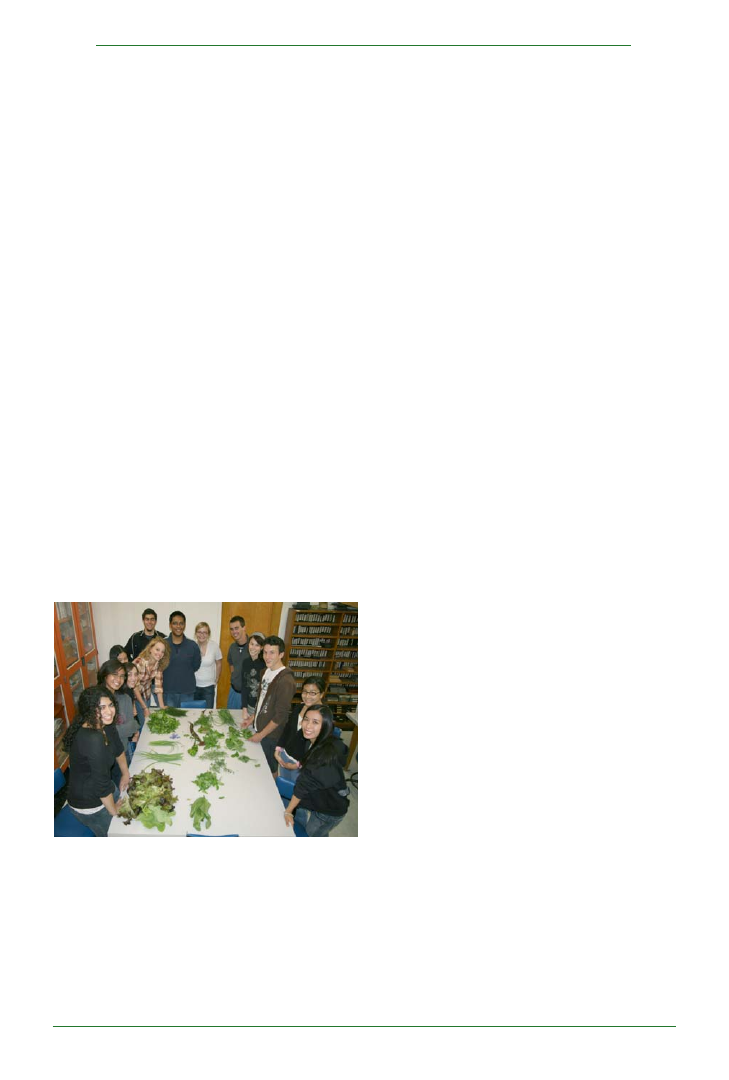
148
Plant Science Bulletin 53(4) 2007
This past year, I changed the course one more time
because it was becoming more and more difficult
to justify teaching a G.E. class of only 45 students.
Most MCDB G.E. classes at UCLA have hundreds
if not thousands of students. The only way it would
be possible to increase the enrollment was to
eliminate the laboratory section and change it into
a one-hour discussion section. This meant that
twice as many students could enroll because
instead of 3 two-hour labs, there would be 6 one-
hour discussion sections. Hence, as a transition,
we eliminated all but the grafting laboratory and
dedicated one hour of the 2-hour laboratory period
each week to gardening. The other hour was used
to read and discuss Michael Pollan’s book “The
Omnivore’s Dilemma”. Fortunately, many of the
topics I covered in my lecture are addressed in the
book, so the students were able to get many lecture
concepts reinforced. The students were divided
into groups and presented two, at the most three,
chapters from the book per week in a PowerPoint
presentation. They also had to expand on some of
the concepts, for example, on mycorrhizae for the
gathering of fungi chapter, on the Haber-Bosch
process for discussions of fertilizer. I attended all
but two of the student presentations and was
impressed not only by their sophistication, but also
by their enthusiasm. I was also impressed by the
differences in the three lab sections, with reference
to the discussion of the chapters and their
impressions of the book. We are not all alike in LA-
LA land.
The idea for the future offering of this course was to
eliminate the gardening aspect of the laboratory
and use the one-hour time period for discussion of
topical books. However, it became clearer to me
over the last several months that majors in MCDB
also have a need for courses, and I had to choose
whether to teach a laboratory course in Plant Biology
for our majors or continue with teaching the non-
majors G.E. I opted for the former. Part of my
decision rested on the fact that fewer and fewer
graduate students at UCLA have either the training
or desire to serve as teaching assistants for
MCDB80, a non-majors course. Currently, I am
thinking of ways to utilize the garden space for the
majors’ course employing it from more of a research
perspective. This too will be a challenge especially
with the current emphasis on more “-omics” type of
science. Nevertheless, I regret the end of MCDB80.
Teaching almost 500 non-biology majors over the
last 16 years the marvels of plant biology from a
variety of perspectives has been an incredible
experience. I hope that the students had as much
enjoyment and learned as much from this course
as I have.
Acknowledgements
In addition to the numerous students and teaching
assistants who have been involved in MCDB80, I
am especially grateful to the Stanley Smith
Horticulture Trust for funds to establish the student
garden.
Ann M. Hirsh. Professor of Molecular, Cell, and
Developmental Biology and the Molecular Biology
Institute, University of California, Los Angeles.
News from the Society
From the Office
If you haven’t done so yet, please take a few minutes
and renew your membership and contact
information online at
https://payments.botany.org/
joinbsa/
. I’m pleased to note we did not increase
fees for 2008. Emeritus/Emerita members,
remember, membership fees in the Society have
been waived. We encourage you to maintain your
sectional affiliations.
We are asking all members to run through the
renewal process. We’d like to ensure your contact
information is up-to-date. Over the coming year we
will be asking you to vote and/or comment on
developments within the BSA.
Invest $10 in the future – give a gift with meaning,
BSA student and associate memberships -
https:/
/ p a y m e n t s . s c i e n t i f i c - c o n f e r e n c e . n e t /
giftmemberships.php.
Bylaws
With the introduction of the office in St. Louis in 2002
and the move to a professional staff supporting the
efforts of the Society, we have moved beyond what
we currently have in place for governance in our
bylaws. This is compounded by changes in non-

149
Plant Science Bulletin 53(4) 2007
profit law and the introduction of the Sarbanes Oxley
Act during the same year. In 2006 the Executive
Committee opened discussions regarding an
update of our bylaws in an effort to become compliant
with the Act. In Chicago, Pam Soltis appointed a
committee including Past Presidents Ed Schneider,
Judy Jernstedt and Scott Russell plus student
representative Andrew Schwendemann and Bill
Dahl to complete the task. During the coming year
you will be asked to ratify the changes.
Strategic Planning
In 2001 we undertook a strategic planning exercise
that led to the formation of the BSA office and staff
team. Other outcomes include continued
development of our educational outreach
(PlantingScience & web updates), additional
support for our scientific meetings & award structure
and relationship building with like-minded
organizations. In Chicago, Pam also appointed a
committee to re-engage the membership in strategic
planning over the coming year. The committee
includes: Pam Soltis; Karl J. Niklas; Christopher
Haufler; Brent Mishler; Gregory Anderson; Simon
Malcomber; Mackenzie Taylor; Gordon Uno; Janice
Coons; Kent Holsinger; Muriel Poston; Theresa
Culley.
BSA Science Education
News and Notes
BSA Science Education News and Notes is a
quarterly update about the BSA’s education efforts
and the broader education scene. We invite you to
submit news items or ideas for future features.
Contact: Claire Hemingway, BSA Education
Director, at
chemingway@botany.org
or Marshall
Sundberg, PSB Editor, at
psb@botany.org
.
PlantingScience —BSA-led student research and
science mentoring program
National Science Foundation supports two BSA-led
projects — The BSA is lead organization on two
National Science Foundation grants awarded
through the Division of Research on Learning in
Formal and Informal Settings (DRL). Through these
projects the Society will address a core objective of
providing improved education about plants.
The 5-year Discovery Research K-12 (DRK12)
project ($1,600,000.00) supports overall
development and delivery of PlantingScience to
secondary teachers and students across the nation.
Mentor recruitment, training, and compensation
efforts will step up as a result. The award will
support critical new program elements of teacher
preparation during summer workshops and
research on classroom implementation conducted
by Co-PI Carol Stuessy at Texas A&M University.
Over the last couple of years, BSA-member
contributions have made PlantingScience a
program that NSF considers a promising, innovative
approach to improving science literacy. Thank you
for your efforts thus far. The fun is only yet begun!
The 3-year Information Technology Experiences for
Students and Teachers (ITEST) project
($900,000.00) is a collaboration among the BSA,
BioQUEST Curriculum Consortium, and Texas A&M
University. The PlantIT Careers, Cases, and
Collaborations project will leverage the strengths of
BioQUEST and PlantingScience to provide
secondary teachers and students with collaborative
learning experiences in plant biology. The project
will offer two phases of engagement. Plant IT
Cases will offer investigative cases integrating
technologies used in the study of plant biology and
in 21
st
Century workplace applications. Plant IT
Collaborations will offer capstone opportunities for
online classroom collaborations. Texas A&M will
also host the ITEST summer teacher institutes and
student camps beginning this summer.
August Inquiry Retreat Sponsored by Monsanto
Fund — August in St. Louis: the air is heavy and
thoughts run deep. It is a great time of year for a
PlantingScience writing retreat. Thanks to the
Monsanto Fund ($80,000.00) we brought together
plant scientists (Larry Griffing, Marshall Sundberg,
Gordon Uno, Paul Williams), high school teachers
(Valdine McLean, Toni Lafferty, and Jane Metty),
and science education specialists (Ethel Stanley
and Carol Stuessy) to develop new plant
investigations. Materials on genetics, respiration,
and growth are in the works now, with alpha
classroom testing this winter.
Next year we will host another writing retreat. We
invite you to contribute!
Introducing the 2007-2008 Master Plant Science
Team — Members of the Master Plant Science
Team (MPST) are compensated for their
commitment to mentor 4-5 student teams in both
the fall and spring PlantingScience sessions. The
2006 inaugural team was a rousing success. Many
thanks to BSA members Rebecca Anderson,
Kandres Halbrook, Donna Hazelwood, Kate
Hertweck, Sonja Maki, Mark Mort, Ely Huerta-
Ortiz, Mackenzie Taylor, Teresa Woods! Their
mentoring insights and extra efforts took

150
Plant Science Bulletin 53(4) 2007
PlantingScience to new heights, showing the value
of a trained and compensated mentoring team
comprised primarily of young scientists.
The 2007 MPST expanded to members sponsored
by both the Botanical Society of America and the
American Society of Plant Biologists. This joint
sponsorship represents a new level of partnership
among plant organizations, which we hope to see
expand as the program grows. I am delighted to
introduce the 2007 Master Plant Science Team,
who are proving their weight in gold:
BSA-sponsored MPST members: Dr. Jenny
Archibald of University of Kansas, Rob Barker of
University of Colorado, Nick DeBoer of University of
Hawaii-Hilo, Jenny Dechaine of University of
Minnesota, Kathy Gerst of University of Arizona,
Kandres Halbrook of University of Arizona, Dr. Carey
Hord formerly of Pennsylvania State University,
Meredith Mertz of Truman State University, Abby
Moore of University of California, Berkeley, Julia
Nowak of University of Guelph, Amber Robertson
of University of Wisconsin-Madison, and Teresa
Woods of Kansas State University.
ASPB-sponsored MPST members: Ed Gilding of
University of Minnesota, Kelly Gillespie of University
of Illinois, Emily Indriolo of Purdue University, and
Chika Nwugo of Miami University, and Aurea
Siemens of University of Alberta.
Mentoring, writing and reviewing new plant
inquiries, contributing to summer workshops.
If you are looking for ways to make major contributions
to improved science education without building a
program from scratch, please email
chemingway@botany.org
.
Spotlight on BSA Member Contributions to
Science Education
Congratulations to Tom Rost and Jim Wandersee
— Winners of the 2007 Charles Edwin Bessy
Teaching Awards!
Dr. Thomas Rost, Assistant to the Director of
International Programs, Professor Emeritus of Plant
Biology, and Botanist Emeritus in the Agricultural
Experiment Station at the University of California,
Davis. He is recognized for his innovative and
outstanding teaching in plant anatomy, including
early and experimental adoption of technology in
his classes. Tom has been active in the BSA
Education Committee and in the Structural and
Developmental Section. He has published over
140 scientific papers on root growth and
development and other anatomical topics, and co-
authored four books, including two general botany
textbooks. Dr. Rost received the Davis Division
Academic Senate Distinguished Teaching Award,
which is the highest teaching award make by each
UC campus.
Dr. James Wandersee, LeBlanc Alumni
Association professor in the College of Education
at LSU, focusing on biological and botanical science
education. He is currently the Chair of the Teaching
Section of the BSA and has presented many papers
and workshops in this section and in the BSA
Educational Forum. He helped coin the phrase
“plant blindness” which was part of a campaign to
help teachers, students, and the general public
overcome their inability to notice plants in their own
environment, which leads to the inability to recognize
the importance of plants in the biosphere and in
human affairs. He is a prolific author, with over 100
publications and several books that have been
translated into six languages. He was elected a
fellow of AAAS, was an officer in the National
Association of Biology Teachers, and is the director
of the 15 Degree Laboratory, A Visual Cognition
Research and Development Laboratory for
Improving Biological and Botanical Learning.
Botany 2007 Education and Outreach Highlights
Here are final highlights on education and outreach
activities at the Chicago meetings.
BioQUEST Curriculum Consortium 2007
Symposium at the Joint Congress — If you
participated in the BioQUEST sessions at the 2002
Inaugural Education and Outreach Forum, you knew
you were in for an engaging opportunity to see the
power of using case-based and problem-based
learning. The six sessions of the 2007 BioQUEST
symposium introduced datasets, simulations, and
resources to support student investigations of plant
pathology, ecology, phylogeography, physiology,
and form. Ethel Stanley and Stacy Kiser kicked off
the sessions with an introduction to case-based
learning. Sam Donovan, Tony Weisstein and Kristin
Jenkins explored phylogeography of the invasive
species Tamarix. Ethel Stanley and Stacy Kiser
shared modeling and simulation resources.
Claudia Neuhauser explored integrating statistics
in undergraduate biology courses. Yaff Grossman
shared Excel simlulations of photosynthesis,
respiration, and growth. Kristin Jenkins shared a
new problem space with gene expression data for
desiccation sensitive and tolerant plants. Maura
Flannery and Ethel Stanley raised often overlooked
issues of visual learning and shared insights from
the 2007 Gordon Conference on “Visualization in
Science and Education: Seeing the Data … and
Beyond!”

151
Plant Science Bulletin 53(4) 2007
Visit the BioQUEST website to access PowerPoint
slides of the talks and links to related resources. In
case you haven’t found it yet, there is a link to
BioQUEST on the BSA website (BSA Suggested
Websites) too.
http://bioquest.org/BSA2007/
Joint ASPB-BSA Education Workshop — Over hors
d’oeuvres Monday evening, there were lively
discussions about how to get involved and make an
impact in education and outreach activities. Six
discussion topics were select to cover a range of the
wide breadth of possible activities that fall within the
scope of the National Science Foundation’s broader
impacts criterion. NSF representatives Judy Skog,
Terry Woodin, and Diane Jofuku Okamuro circulated
among the roundtables.
Individuals active in both BSA and ASPB with
experience taking ideas to impact served as thought
leaders. Gordon Uno, who has infused inquiry
teaching and learning in botany courses at University
of Oklahoma and co-authored inquiry-bases botany
texts, led a discussion targeting undergraduate
education. Phil Gibson, who with his wife is currently
writing their third scientific book for youth, shared
his experiences working with publishers and
presenting science to a young audience. Paul
Williams, creative genius behind Rapid Cycling
Brassicas (a.k.a. Wisconsin Fast Plants), posed
provocative questions about working with K-12
teachers and creating cultural shifts in science and
education partnerships. Erin Dolan and I drew on
the Partnership for Research and Education in
Plants and PlantingScience programs to focus a
broad discussion on scientist-student-teacher
partnerships. David Salt used his experience
creating plant-related museum displays as a
springboard to collaborations between scientists
and museums, botanic gardens, and other public
institutions. Eve Wurtele, developing the Meta!Blast
video game of Cell and Metabolic Biology, led a
discussion on computer and web-mediated
learning environments.
An exit survey indicated that participants enjoyed the
informal opportunities to talk about a diversity of
educational efforts that meaningfully address
Broader Impacts and enhance connections
between scientists and the community.
One immediate outcome of this workshop is an
introductory set of resources to assist faculty in
starting broader educational and outreach
endeavors. You’ll find a pdf of these on the BSA
website under Outreach.
What kinds of Education and Outreach sessions
you would like to see at future Botany meetings?
Please send your ideas!
Education Bits and Bobs
How will US high school students rank in advanced
math and science tests across nations? — We will
not know the answer to that question. The US has
decided to opt out of the 2008 international testing
of advanced math and science students. Read
more about the issues underlying this decision in
an article by Jeffery Mervis. Science 317: 1851.
Learn more about the TIMMS and TIMMS-A at
http://nces.ed.gov/timss/
What does it take to build a lunar growth chamber?
— As NASA plans to return to the moon, plant growth
will be an important part of space exploration. NASA
scientists anticipate that astronauts may be able to
grow plants on the moon in specialized plant growth
chambers. Through the 2007-2008 NASA
Engineering Design Challenge, elementary, middle
and high school students are invited to:
(1) Design, build, and evaluate lunar plant growth
chambers;
(2) Receive cinnamon basils seeds flown on STS-
118;
(3) Test lunar growth chambers by growing and
comparing both space-flown and earth-based
control seeds.
http://www.nasa.gov/audience/foreducators/
plantgrowth/home/index.html
Editor’s Choice
Nicholson, Barbara J. and Sylvia C. Halkins. 2007.
Temperature relationships in Eastern skunk
cabbage. Bioscene: Journal of College Biology
Teaching 33(2) 6-14.
In these activities the color, shape, and orientation
of spathes and stage of flower maturation are
examined for their possible roles in metabolic heat
production. Activities are also presented for
comparing the role of metabolic heat vs solar heat
in heat retention of the inflorescence and a final
activity examines the potential correlation between
heat and odor production. The activities can be
modified for use at all levels from middle school
through upper-level college courses. For each
activity, sample student data is presented and
discussed. The data was generated over several
years, but the timing of publication is perfect for use
this spring!
Wilson, Christopher D., Charles W. Anderson,
Merle Heidemann, John E. Merrill, Brett W. Merritt,
Gail Richmod, Duncan F. Sibley, and Joyce M.
Parker. 2006. Assessing Student’ Ability to Trace
Matter in Dynamic Systems in Cell Biology. CBE-
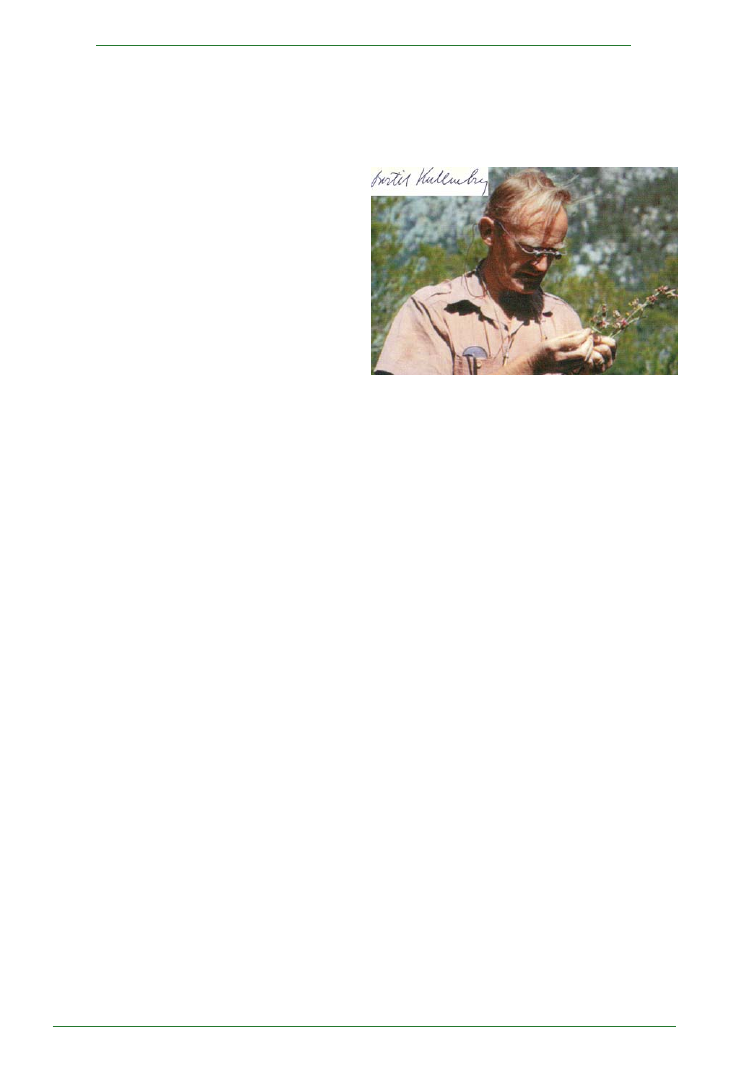
152
Plant Science Bulletin 53(4) 2007
Life Sciences Education 5(4):323-331.
http://www.lifescied.org/cgi/reprint/5/4/323
Three batches of radish seeds started with the
same dry weight. After 1 week, the seeds that were
watered but grown in the dark had a lower dry weight
than when they started. “Where did the mass go that
was lost by the seedlings…?” This is one of several
questions dealing with common misconceptions
about photosynthesis and respiration that are
addressed in this article. The discussion of the
qualitative assessments used by the authors
provide many intriguing ideas about how to improve
your instruction of these basic concepts.
Douglas L. Wendell and Dawn Pickard. Teaching
Human Genetics with Mustard: Rapid Cycling
Brassica rapa (Fast Plants Type) as a Model for
Human Genetics in the Classroom Laboratory
CBE Life Sci Educ 2007: 179–185
http://www.lifescied.org/cg
This activity presents a paternity problem using
Fast Plants ™and DNA microsatellite markers. The
authors provide complete protocols for obtaining
meaningful results in a teaching laboratory geared
to a semester-long, upper division undergraduate
laboratory in genetics (3-hr, once a week). Although
the exercise was developed and presented as a
model for teaching human genetics, it has the
added benefit of emphasizing that plants have sex
too!
A Call to Student Members
At the Missouri Botanical Garden’s Annual
Systematics Symposium few weeks ago I was
talking with Mary Barkworth about students’ requests
for on-line identification keys to help them identify
local specimens. We realized that while both of us
rely on printed keys, there are probably on-line
resources out there that would be appropriate to
recommend but that we just don’t know about. She
suggested that the best way to get this information
would be to ask students what resources they find
useful,
SO--
Here’s a call to the student membership of BSA!
Send the URL’s and a brief critique of your favorite
on-line botanical resources to the Plant Science
Bulletin (
psb@botany.org
) and we will make this
information available - - to your peers AND YOUR
MENTORS!
(Be sure to include your name and school.)
Announcements
In Memoriam:
Bertil Kullenberg (1913-2007)
A French magistrate in Algeria, A. Pouyanne and the
British student of orchids, M. J. Godfery wrote about
the pollination of Ophrys between 1917 and 1930
and described a form of entomogamy which is now
called pseudocopulation. Similar observations
with Cryptostylis in Australia were published by Mrs.
E. Coleman between 1928 and 1938. These
phenomena were intriguing and became known
relatively quickly, but the reasons for the insects’
behavior remained relatively obscure until Professor
Kullenberg studied them between 1945 and 1979
using methods which were very advanced for the
time. These include: 1) a custom made ultraviolet
light transmitting quartz lens which made possible
UV reflection photography and images that
approximated what the pollinators may be seeing,
2) gas chromatographs, 3) mass spectrometers,
and 4) concern with chemically active odors like
pheromones. What he found was that the flowers
produce volatile substances which act as female
sexual stimuli and lead the males to attempt
copulation. Pollination of Ophrys depends on this
because the flowers do not produce nectar.
Bertil Kullenberg was born in 1913 in Gothenburg,
Sweden and first became associated with Uppsala
University in 1933. He defended his thesis in 1944
and became an associate professor in the same
year. Four years later he was appointed research
professor of Entomology and served in that capacity
until 1968 when he became a full professor.
Professor Kullenberg retired in 1979. Between these
activities he found time to marry Anna-Lis Apelgårdh
in 1940 who functioned as his unpaid secretary,
field assistant and driver during his entire career.
She also bore their three children, Barbro (1941),
Gunnar (1945) and Gunhild (1947).

153
Plant Science Bulletin 53(4) 2007
During his career Kullenberg studied (in Sweden
as well as in the Mediterranian area and in Africa)
capsids, bird migration and communications
between organisms. The latter lead him to Ophrys
pollination through pseudocopulation and to what
in my view are some of the most important
contributions ever to our understanding of orchid
biology (for a summary see Kullenberg, 1961, 1984).
One of his students, Prof. Lennart Ågren wrote that
Dr. Kullenberg’s research in this area was facilitated
by “his well trained nose, curiosity, and patience in
almost innumerable excursions.”
Professor Kullenberg was not a plant scientist as
such and I doubt that he would have called himself
an orchid specialist. Still, he made highly significant
contributions to orchid science. My own recollections
of him go back the International Botanical Congress
in Leningrad in 1974. On that occasion he showed
what can be described as an orchid blue movie
which showed wasps copulating with Ophrys
flowers. I, an aspiring orchid biologist at the time,
introduced myself and found Dr. Kullenberg to be a
very knowledgeable, nice, kind and considerate
person who did not talk down to a beginner. I tried
to follow his example during my career.
–Joseph Arditti, Professor Emeritus of Biology,
University of California, Irvine.
Literature Cited
Kullenberg, B. 1961. Studies in Ophrys pollination. Reprinted
from Zoologiska Bidrag Fran Uppsala, Band 34. Almqvist
& Wiksells Boktryckeri AB, Uppsala, Sweden.
Kullenberg, B 1984. The Ecological Station of Uppsala
University on Öland: A summarizing presentation of its
history and research programmes. Nova Acta Regiae
Societatis Scientiarium Upsaliensis, Ser. V:C, 3, 7-14.
Robert R. Nakamura (1954-2006)
Many BSA members mourn the passing of Dr.
Robert Nakamura, who died of natural causes at
the age of 52 in September 2006. Bob was an
associate professor of Biology at California State
University/Los Angeles, where he was highly
regarded as a teacher, mentor, and scholar. Bob
grew up in a Japanese-American family with deep
roots in California. He is survived by his father, his
brother, sister-in-law, and a large extended family.
Bob graduated from Stanford University in 1976
after majoring in Biology, and went on to complete
his M.Phil. (1979) and Ph.D. (1983) at Yale University.
After several years of postdoctoral research at the
University of California at Davis, the Weyerhauser
Company, and the University of Washington, he
joined the faculty at Cal State L.A. in 1991. Returning
to Los Angeles and living near his parents was
rewarding to him. On his faculty website, he wrote,
“”When I took up my faculty position at Cal State L.A.,
I returned to the city of my birth. Here I first discovered
nature in backyard gardens and fish ponds, in
wondrous museum displays and in fascinating
ocean tide pools.”
Throughout his career, Bob studied novel and
interesting questions in plant evolutionary ecology.
His papers on mate choice and plant reproductive
biology appeared in journals such as the American
Journal of Botany, Evolution, Ecology, and Heredity.
At Cal State L.A., Bob was a leader in developing an
integrated curriculum in environmental science.
He taught courses in plant biology, ecology, natural
history, and writing for biologists. He also studied
the assessment of student learning and the needs
of under-represented minority students. Philip
LaPolt, chair of the Department of Biological
Sciences at Cal State L.A., noted that “Bob
contributed in countless ways to his Department,
College, and University. His gentle warmth, sincerity,
and sense of humor endeared him to students,
staff, and colleagues alike.”
Bob’s colleague at Cal State L.A., Dr. John Gamon,
made the following comments at his memorial
service:

154
Plant Science Bulletin 53(4) 2007
I had the privilege of knowing Bob for most of my
adult life. I first met him as my TA when I was an
undergraduate at Yale in the late 1970s. In 1991,
when I was hired as an Assistant Professor in Plant
Biology at Cal State L.A., I learned that the one other
hire the department made that year was another
Plant Biologist named Bob Nakamura. So it was
with considerable delight that I started teaching that
fall with someone who, by that time, had become a
good friend. On campus, we shared a lab space for
about five years, and I was always amazed by how
tolerant Bob was of whatever happened in our
shared workspace. For four additional years, we
worked together on a student training grant
sponsored by NSF. Remembering Bob, one faculty
member spoke of “Bob’s kindness, his even
demeanor, and the quiet way he went about
accomplishing so much.” Another put it this way:
“Bob was one of the most gentle people I have ever
known.” He will clearly be remembered as someone
who made a difference in the many lives he touched
along the way.
These comments reinforce my own memories of
Bob’s friendship and collegiality. I first met Bob in
1984, when he joined Maureen Stanton’s lab group
at UC/Davis, and we remained in touch ever since.
Over the years, I could always count on Bob for
helpful professional advice, enlightening
conversations, and good cheer. He was a very
generous person who lived his life simply and
thoughtfully, with a great deal of empathy for others.
Donations to the Robert R. Nakamura Memorial
Scholarship may be made by sending a check to the
California State University Los Angeles Foundation,
5151 State University Dr., Admin. 809, Los Angeles,
CA 90032. Checks should be made payable to the
CSULA Foundation and in the memo section of the
check it should list the Robert R. Nakamura Memorial
Scholarship.
Respectfully submitted by:
Dr. Allison Snow
Department of Evolution, Ecology, and Organismal
Biology, Ohio State University, Columbus, OH 43210
snow.1@osu.edu
Judith D. Zuk (1952-2007)
Horticulturist, Educator, and
Botanic Garden Executive
Judy Zuk, President Emeritus of Brooklyn Botanic
Garden, one of America’s preeminent botanic
gardens, died in Brooklyn on Saturday, September
1, 2007 after a long illness.
Ms. Zuk led the Botanic Garden for more than 15
years and was only the fifth president in its nearly
100-year history. Prior to coming to Brooklyn in
1990, she was the director of the Scott Arboretum of
Swarthmore College in Pennsylvania.
“Judy was an extraordinary and adored leader, who
guided the Garden through the planning and
execution of major capital projects, the expansion
of its horticultural, scientific and education programs
and the creation of its master plan for the future,”
said Brooklyn Botanic Garden board chairman Earl
Weiner. “Her death represents an enormous
personal loss to all of us who loved and admired
her, as well as to the worldwide horticultural
community. I am consoled by the knowledge that
her extraordinary contributions to the Garden will be
enjoyed by visitors for many years to come.”
Ms. Zuk studied botany at Rutgers University,
graduating summa cum laude in 1973. She then

155
Plant Science Bulletin 53(4) 2007
received a Master’s in Public Garden Administration
from the University of Delaware, and was awarded
a Garden Club of America fellowship to study
landscape design in England. Ms. Zuk was co-
editor-in-chief of The American Horticultural Society
A-Z Encyclopedia of Garden Plants. She served on
the boards of many professional and cultural
organizations, including Botanic Gardens
Conservation International, and as chair of the
Cultural Institutions Group in New York City.
Ms. Zuk was widely recognized for her leadership in
American horticulture and received many
prestigious awards including the Medal of Honor
from the Garden Club of America. In 2004, the
American Association of Botanical Gardens and
Arboreta chose Zuk, its former Board president, to
receive its Honorary Life Member Award, the
Association’s most prestigious award. On her
retirement in 2005, Brooklyn Botanic Garden
celebrated Ms. Zuk by the naming of the Judith D.
Zuk Magnolia Plaza at the Garden and of a magnolia
cultivar developed by the Garden, Magnolia x ‘Judy
Zuk.’
Ms. Zuk is survived by her sister, Patricia Campbell,
of China Grove, North Carolina, and nephew Ian. A
celebration of her life is planned for September 23
at the Botanic Garden.
Personalia
Dr. Peter Raven Receives Verrill
Medal From Peabody Museum
Dr. Peter Raven, president of the Missouri Botanical
Garden, has received the Addison Emery Verrill
Medal from the Peabody Museum of Natural History
at Yale University. Raven and noted Harvard
environmentalist Edward O. Wilson each received
the award for outstanding achievement in the natural
sciences.
Raven is a world-renowned botanist and authority
on plant evolution. Described by TIME Magazine as
a “Hero for the Planet,” he is an advocate for
biodiversity and a sustainable environment. He is
the recipient of numerous awards and honorary
university degrees, including the National Medal of
Science and an honorary Doctor of Science degree
from Yale University.
The Verrill Award is the Peabody Museum’s highest
honor and has been awarded only 15 times. It was
established in 1959 in honor of Addison Emery
Verrill (1839-1926), Yale’s first professor of zoology.
Raven and Wilson received their awards on Oct. 17
during a program they jointly presented at Yale
entitled “The Future of Life on Earth.”
Photo by Christiane Anderson, 2007
Robert Allerton Award for
Excellence in Tropical Botany or
Horticulture
to
Dr. William R. Anderson
The National Tropical Botanical Garden (NTBG)
has announced that Dr. William R. Anderson will
receive the Robert Allerton Award for Excellence in
Tropical Botany or Horticulture for 2007. The award
will be presented October 8 during the institution’s
semi-annual Board of Trustees meeting. The
Allerton Award is given bi-annually to recognize
specific achievements or a lifetime of achievements
in tropical plant science. The award was initiated in
October 1975 and is named to honor one of NTBG’s
founding trustees and its principal initial benefactor.
“Bill Anderson has been a major influence in the
world of tropical botany, from his decades of research
to his devotion in teaching generations of future
botanists,” stated NTBG CEO and Director Chipper
Wichman. “His passion to spend his life studying

156
Plant Science Bulletin 53(4) 2007
and sharing his knowledge about tropical plants is
truly admirable. It is our honor to present this award
to Bill.”
Colleagues credit Anderson with anticipating by 25
years the links between plant systematics and
ecology that are now widely in evidence. During his
lifetime of selfless dedication to the discipline of
plant taxonomy, he served as director of the University
of Michigan (UM) herbarium, one of the largest
university herbaria in the world, and currently holds
the title of Curator Emeritus of Vascular Plants. He
has taken the lead in understanding the
complexities of the large tropical plant family
Malpighiaceae, commonly known as the Barbados
Cherry family, and continues this research to this
day. Now Professor Emeritus of Botany at the
University, Anderson devoted many years to training
an extraordinary number of undergraduate and
doctoral students, many of which have gone on to
prominent positions in plant science. His success
as a mentor is evidenced by the fact that nearly all
of his doctoral students have been awarded
dissertation grants from the National Science
Foundation.
His own research has received some 25 grants
from the Foundation, including early in his career as
an NSF Graduate Fellow, throughout his career for
fieldwork in Brazil, Mexico, Venezuela, Bolivia,
Argentina, and Costa Rica, and for his current
collaborative research with his wife and fellow
botanist, Christiane, and a researcher from Harvard
University. Anderson has published over 70 scientific
papers and served as general editor for eight
volumes of the monumental Flora Novo-Galiciana.
He is a past president of the American Society of
Plant Taxonomists and served for 15 years on a
committee for the International Association for Plant
Taxonomy.
Anderson says he will speak on the “Highs and
lows of tropical fieldwork” at the awards ceremony.
“Research in plant systematics is fun and
fascinating, but it can also be lonely and frustrating,”
commented Anderson. “It took me years of solitary
study to learn enough about the Malpighiaceae that
I could start to add to what was already known, and
unraveling evolutionary history is the most
intellectually challenging work imaginable. Learning
that I was to receive the Allerton Award from the
National Tropical Botanical Garden was therefore
not only deeply gratifying; it was also a validation of
40 years of arduous and joyous scholarship.”
It consists of a bronze medal and a $1,000
honorarium. The National Tropical Botanical Garden
is a not-for-profit institution headquartered in the
only tropical zone in the United States. Its mission
is to enrich life through discovery, scientific research,
conservation, and education by perpetuating the
survival of plants, ecosystems, and cultural
knowledge of tropical regions. NTBG has over
1,800 acres in gardens and preserves in the
Hawaiian Islands and in South Florida. It is the only
tropical botanical garden chartered by the U.S.
Congress.
There once was a teacher
Whose principle feature
Was hidden in quite an odd way.
Students by millions
Or possibly zillions
Surrounded him all of the day
When finally seen
By his scholarly dean
And asked how he managed the deed,
He lifted three fingers
And said, “All you swingers
Need only to follow my lead.
To rise from a zero
To Big Campus Hero
To answer these questions you’ll strive:
Where am I going
How shall I get there and
How will I know I’ve arrived?
A Limerick by Robert Mager

157
Plant Science Bulletin 53(4) 2007
State Department Names Dr. Nina
V. Federoff New Science Adviser
United States Secretary of State Condoleezza Rice
has named Dr. Nina V. Federoff to be her new
Science and Technology Adviser. Federoff, a plant
molecular biologist, is the Willaman Professor of
Life Sciences and Evan Pugh Professor in the
Department of Biology and the Huck Institutes of the
Life Sciences at Pennsylvania State University.
Established in 2000, the Secretary’s Science and
Technology Adviser serves as the State
Department’s chief scientist and principal liaison to
the national and international scientific
communities. Federoff is the third person to hold
the post.
Among the chief responsibilities of the S&T Adviser
are: enhancing the scientific literacy at the
Department of State; increasing the number of
scientists working for the Department of State, both
domestically and overseas; building bridges to the
scientific community; and, providing timely
information on emerging S&T issues with
implications for foreign policy. Federoff’s research
has centered on the molecular biology of plant
genes and transposons, as well as plant
adaptations to stressful environments.
Rachel Carson Envionmental
Award to Michael J. Balick
Michael J. Balick, Ph.D., Vice President and Director
of The New York Botanical Garden’s Institute of
Economic Botany, is this year’s recipient of the
Natural Products Association’s Rachel Carson
Environmental Award. This award was created to
recognize individuals who have made outstanding
contributions to the environmental community.
In presenting Dr. Balick the award at their national
annual convention on July 20-22, 2007, the Natural
Products Association cited the breadth of his
accomplishments in the field of ethnobotany. Of
particular
interest was his extensive work involving
ethnopharmacological studies-the search for plants
with medicinal properties-particularly his fieldwork
in Belize that lead to the formation of the world’s first
ethno-biomedical forest reserve. Together with Drs.
Rosita Arvigo and Gregory Shropshire, he co-founded
the Ix Chel Tropical Research Foundation, a center
in Belize devoted to traditional healing and cultural
preservation. From 1986-1996 he helped lead a
collaboration between The New York Botanical
Garden and the US National Cancer Institute to
survey Central and South America and the Caribbean
for plants with potential applications against cancer
and AIDS.
For nearly three decades, Dr. Balick has studied the
relationship between plants and people, working
with traditional cultures in tropical, subtropical, and
desert environments. He specializes in ethnobotany,
working with indigenous cultures to document their
plant knowledge, understand the environmental
effects of their traditional management systems,
and develop sustainable utilization systems-while
ensuring that the benefits of such work are always
shared with local communities. Dr. Balick is an
expert on the palm family, an economically important
family of plants in the tropics. In 1981 he co-founded
The New York Botanical Garden’s Institute of
Economic Botany with Sir Ghillean Prance. The
largest and most active program of its kind in the
nation, the Institute is devoted to furthering
knowledge of the relationship between plants and
people. As part of his work, Dr. Balick has established
numerous collaborations between communities,
governmental and non-governmental
organizations, and institutions in the United States
and Europe all working towards the common theme
of discovering plants with potential therapeutic uses.
Kenneth G. Karol joins Staff at New
York Botanical Garden
In September 2007, Kenneth G. Karol, Ph.D., joined
the Science staff of The New York Botanical Garden
as Assistant Curator in the Lewis B. and Dorothy
Cullman Program for Molecular Systematics
Studies. His scientific research is focused primarily
on evolutionary studies among freshwater green
algae (specifically the “charophytes” or
“stoneworts”), which are thought to be the closest
living relatives of all land plants. During recent
years, Dr. Karol has been investigating differences
in the chloroplast genome structure among species
of algae, mosses, and ferns to better understand
the origin and evolution of plants. He earned his
Ph.D. degree in Plant Biology at the University of
Maryland and a Bachelor of Science in Botany from
the University of Wisconsin, Madison. Dr. Karol
comes to the Botanical Garden from a postdoctoral
fellowship at the University of Washington in Seattle.

158
Plant Science Bulletin 53(4) 2007
The Fourth International Conference
on
The Comparative Biology of the
Monocotyledons
The Fifth International Symposium
on
Grass Systematics and Evolution
Copenhagen, Denmark
11-15 August 2008
General Information
The Fourth International Conference of The
Comparative Biology of the Monocotyledons & The
Fifth International Symposium of Grass Systematics
and Evolution will take place in 2008 in Copenhagen,
Denmark. The organizing committee consists of
members from The Natural History Museum of
Denmark and the biological departments of the
Universities of Aarhus and Copenhagen.
Purpose
To bring leading scientists from all over the world
together to Copenhagen to present and discuss the
latest developments in the field of monocot and
grass evolution.
Registration
Registration is open to anyone interested in the
evolution of the monocotyledons and grasses.
Payment of the registration fee allows access to all
sessions. Reduced fees will apply to students.
Congress Site
The conference site is in the northern campus area
of the University of Copenhagen close to the
Zoological Museum.
Language
The official language is English.
Highlights
The congress will convene at the opening session
on Monday, 11 August 2008 with welcoming
ceremonies and plenary lectures, starting with the
Rolf Dahlgren lecture. The scientific program will
take place from Monday through Friday. Scientific
events will end daily at 17:00. A reception hosted by
the City of Copenhagen will take place at the Town
Hall. The conference dinner will be held in the Tivoli
Gardens.
Symposia, Conferences,
Meetings
The Scientific Program
The program will – in the tradition of previous
meetings – consist of plenary lectures, invited, and
contributed papers. There will also be a poster
session. The scientific program will have parallel
sessions.
Planned scientific program
• Evolution and phylogeny of the Monocotyledons
• Evolution and phylogeny of the major orders (APG
II) of the Monocotyledons (e.g., Acorales plus
Alismatales, Asparagales, Dioscoreales, Liliales,
Pandanales, Commelinales, Poales, and
Zingiberales)
• Special sessions on Poaceae, Arecaceae, and
Orchidaceae
All authors (oral contributions and posters) will
have to supply abstracts.
Ode to Johnson Grass
Some years ago it came to pass
A bright guy sowed some Johnson Grass.
Great claims were made for this new hay,
“Twould make our Southern farmin’pay.”
Today when neighbors cuss and shout
It’s Johnson Grass they rave about.
It seems unjust to so defame
A grass that’s lived up to its claim.
It’s easy spread and easy sowed,
It’s easy grazed and easy mowed:
It’s only fault most folks agree,
Is runnin’ on eternally.
The praise this honest grass once got,
Has turned to epithets that’s hot.
Our editors to educate,
Head columns up: “Eradicate!”
It seems to me quite out of place
To damn a grass that’s fell from grace.
This grass, sez I, don’t mean no harm
It just runs loafers off the farm.
The best of farmers cuss and shout,
But after all, they clean it out,
It holds the soil in firm embrace,
Until a real man gets the place.
A crop of hay as smart as that,
Just makes me bow and lift my hat.
-W.H. Darrow

159
Plant Science Bulletin 53(4) 2007
Seed Bank Technician at Chicago
Botanic Garden
The Chicago Botanic Garden seeks a technician
to assist with the collecting, processing, and
seed banking of 1500 native plant species of
the Midwestern United States as part of the U.S.
“Seeds of Success” project and the international
Millennium Seed Bank Project at Royal Botanic
Gardens, Kew. Under the supervision of the
Seed Bank Coordinator, the Seed Bank
Technician will assist with all activities
associated with managing the seed bank. S/he
will assist with collecting seed and herbarium
specimens, scouting natural areas for plant
populations for collections and ensuring
collecting permits are up to date. S/he will also
process and store collected seed, assist in the
periodic testing of seed viability, and enter
herbarium and seed collection data into an
Access database. The seed bank technician will
prepare periodic shipments of seeds and
herbarium specimens, help manage our
volunteer staff (typically 5-10 volunteers), and
conduct regular volunteer seed cleaning days.
For more information, see the project Web site
(
http://www.cbgseedbank.org/
).
Position requirements: Bachelor’s degree in
biology, botany, ecology, or a related major and
a keen interest in the conservation and
restoration of native plants. The Seed Bank
Technician must be able to work independently
and as part of a team. S/he must be organized
and detail oriented. The Technician must be
willing to work outside (sometimes in remote
locations and under harsh conditions), must be
willing to travel (occasionally overnight and on
weekends) and hold a valid driver’s license.
Candidates should have skills in plant
identification and herbarium techniques,
familiarity with Midwestern flora, and previous
experience conducting fieldwork. Computer
skills, especially with Microsoft Access, are
preferred. Review of applications will begin on
November 1 and continue until a suitable
candidate is hired.
Application procedure:
Send a resume and three letters of reference to:
Human Resources Department
Re. Seed Bank Technician Position
Chicago Botanic Garden
1000 Lake Cook Rd.
Glencoe, Illinois 60022
Or E-mail
employment@chicagobotanic.org
Senior Plant Scientist
The Chicago Botanic Garden (CBG), in collaboration
with Northwestern University, invites applications
for a SENIOR PLANT SCIENTIST position. Applicants
should be broadly trained in plant biology or ecology
in a subfield that will complement some aspect of
our current research expertise in restoration ecology,
conservation biology, soil ecology, population
genetics, plant systematics and economic botany.
Particular specialties of interest include global
change biology, invasion biology, spatial ecology,
seed physiology, or conservation policy. Duties
include conducting an active research program
with external funding, collaborating with a wide
range of academic and stewardship organizations,
and oversight of some of the Garden’s plant biology
research staff. The new Senior Plant Scientist will
join a team of eleven Ph.D. researchers and
participate in teaching in an innovative joint Master’s
program in Plant Biology and Conservation with
Northwestern University, and will help contribute to
the development of a joint doctoral program with
NU.
Candidates must have a Ph.D. in plant biology,
ecology, or a related discipline, a strong record of
scholarship, an excellent extramural funding record
for research, experience advising students at the
doctoral level, and a commitment to undergraduate
and graduate education. Please send a curriculum
vitae, statements of research plans and teaching
interests, examples of scholarly writing and three
letters of reference (mailed directly from referees)
to the address below. Review of applications will
begin October 15, 2007 and continue until a suitable
candidate is found.
Senior Plant Scientist Search Committee
Attn: Dr. Larry DeBuhr
Chicago Botanic Garden
1000 Lake Cook Road
Glencoe, IL 60022
or
ldebuhr@chicagobotanic.org
(electronic correspondence preferred)
CBG is situated on a 385-acre campus north of
Chicago and showcases 23 different demonstration
gardens as well as native areas that include
woodlands, prairies and aquatic habitats, each
featuring native and endangered Illinois flora (
http:/
/www.chicagobotanic.org
).
The Chicago Botanic Garden and Northwestern
University are Equal Opportunity/Affirmative Action
Employers. Applications from women and minority
candidates are encouraged.
Positions Available

160
Plant Science Bulletin 53(4) 2007
CURATOR OF BOTANY, John T.
Howell Curatorial Chair of Western
North American Botany at the
California Academy of Sciences
The California Academy of Sciences invites
applications for the John T. Howell Curatorial Chair
of Western North American Botany. Applications for
this full-time position at the Assistant Curator level
are solicited from individuals with a primary interest
in, and commitment to, active field- and collection-
oriented research in the systematics and evolution
of plants in western North America, including
California. We seek an individual who will participate
in the diversity of research, educational, and
administrative activities at the Academy; contribute
to the maintenance and development of a major
herbarium; and bring complementary or new
research techniques to the Department of Botany.
Opportunities for mentoring students are available.
The Academy’s Department of Botany houses a
worldwide herbarium of 1.9 million specimens of
vascular plants, bryophytes, and lichens. The
collection of flowering plants from California is the
largest in existence. Current collection growth is
focused on plants from Latin America, eastern Asia,
Madagascar, and western North America. Major
research projects are currently underway in China,
Madagascar, and parts of Central and South
America. Other institutional research resources
and facilities include an SEM laboratory, the Center
for Comparative Genomics, and a comprehensive
library of systematic and evolutionary biology. For
additional information about the California Academy
of Sciences and its Department of Botany, please
visit
http://www.calacademy.org
and
http://
www.calacademy.org/research/botany
.
Candidates must have a Ph.D. and an active
research program (or a willingness to begin such)
in plants of western North America. Preference will
be given to candidates who combine traditional,
collections-oriented research with molecular
phylogenetic techniques. Salary is negotiable and
a generous benefits package is provided.
Applicants should forward a letter of interest, a
curriculum vitae, description of research goals,
copies of pertinent publications, and the names
(along with contact information) of three references
by 15 January 2008 to California Academy of
Sciences, Human Resources Department
#HOWELLcurator, 875 Howard St., San Francisco,
California 94103, U.S.A. The California Academy of
Sciences is a natural history museum, aquarium,
planetarium, and research institution located in
San Francisco. It is an Equal Opportunity Employer
committed to diversity.
John J. Rose Postdoctoral
Fellowship in Botany.
The California Academy of Sciences invites
applications for the John J. Rose Postdoctoral
Fellowship in Botany. Applications for this full-time
position are solicited from individuals with a primary
interest in, and commitment to, active field- and
collection-oriented research in the systematics and
phylogenics of vascular plants using contemporary
techniques. We seek an individual who will
participate in our research programs in diverse
geographic areas and contribute to the development
of a major world-wide herbarium.
The Academy’s Department of Botany houses an
herbarium of nearly 1.9 million specimens of
vascular plants, bryophytes, and lichens. Current
collection growth is focused on plants from Latin
America, eastern Asia, (particularly China),
Madagascar, and western North America
(especially California, Nevada, and Arizona). We
currently have active research programs in China,
Madagascar, and parts of Central and South
America. Other institutional research resources
and facilities include a SEM unit, the Center for
Comparative Genomics, and a comprehensive
library of systematic and evolutionary biology. For
additional information about the California Academy
of Sciences and its Department of Botany, please
visit
http://www.calacademy.org
and
http://
www.calacademy.org/research/botany
.
Candidates must have their Ph.D. prior to beginning
the position. This is a one year position with possible
extension to two years based on performance.
To apply, send a letter of interest, a curriculum vitae,
a general description of research goals, and a
proposed project to be conducted during the
fellowship period. Please also include the names,
addresses, e-mails, and telephone numbers of
three references. Send applications to: Human
Resources Department #ROSEpostdoc, 875
Howard Street, San Francisco, CA 94103.
Applications will be considered beginning Nov. 15,
2007 for a starting date in 2008. The California
Academy of Sciences is a Natural History Museum,
Aquarium, Planetarium, and Research Institution
located in San Francisco. The Academy is an Equal
Opportunity Employer and welcomes applications
from individuals who will contribute to its diversity.

161
Plant Science Bulletin 53(4) 2007
Experience in Tropical Botany
Harvard University Summer School, in collaboration
with The National Tropical Botanical Garden
announces the following course in 2008.
Dates: June 2 to June 28 2008
Location: The Kampong Garden of the National
Tropical Botanical Garden, 4013 Douglas Road,
Coconut Grove, Miami FL 33133
The Class will use the newly constructed teaching
Kenan Laboratory at The Kampong (wet bench and
microscope facilities) and be accommodated in
comfortable dormitory style housing in the same
location (Scarborough House).
Course title: “Biodiversity of Tropical Plants”
Instructor: Professor P. Barry Tomlinson
Professor of Biology Emeritus, Harvard University &
Crum Professor of Tropical Botany, National Tropical
Botanical Garden.
The course is intensive and intended to present an
overview of the rich diversity of tropical plants in
natural environments (e.g. The Everglades National
Park, Biscayne Bay National Park) and especially
rich collections of introduced tropical plants at
collaborating Institutions, notably Fairchild Tropical
Botanic Garden and The Montgomery Botanical
Center, Coral Gables. This tropical resource is
unmatched elsewhere in the Continental United
States.
Emphasis is on morphology and anatomy in a
systematic but also functional context and involves
both field and laboratory study. The course structure
is extensively enquiry- based and is intended to
develop skills in investigative techniques and
philosophical approaches which can be applied
subsequently in Graduate Study. Students are
introduced to many tropical plant families (especially
the iconic Arecaceae) and such topics as, e.g., tree
architecture, pollination biology, the morphology of
vines and epiphytes as well as distinctive tropical
ecosystems like seagrass meadows and
mangroves. Laboratory work emphasizes anatomy
and dissection of fresh material, using implements
ranging from chain saws to scalpels.
Admission to the course depends on some
demonstrated previous familiarity with at least
elementary Botany and is intended to cater for
students who are already enrolled in a graduate
program in Botany or Biology or plan to do so in the
near future.
Students will be required to register with The Harvard
Summer School and will receive 4 credits.
Estimated Cost.: Harvard Summer School tuition;
travel to and from Miami; Kampong accommodation
at $25 per day. Tuition and Travel scholarships may
be available for qualifying students.
For further information:-
P.B. Tomlinson at the above Miami address, or
Harvard Forest, Harvard University, 324 N.Main St.
Petersham MA 01366
e-mail:
pbtomlin@fas.harvard.edu
And Harvard Summer School on-line in 2008
Manager, Conservation Training
Programs
at the Chicago Botanic Garden
The Chicago Botanic Garden seeks a Conservation
Scientist and Manager for its award-winning
Conservation and Land Management Intern
Program for its Plant Science and Conservation
Division. Duties include management of the intern
program, including recruitment, hiring, training and
placing approximately 100 interns per year for
several land management agencies
(approximately 60% time) and conducting an active
conservation-oriented research program (40%
time). The successful candidate will have the
opportunity to work with graduate students from
several Chicago region universities if desired.
Requirements include a Ph.D. in ecology, botany,
biology or a related field, expertise in restoration
ecology or land management practices/policy, and
a desire to work in a non-profit environment. Must
have excellent organizational and communication
skills and maintain strong working relationships
with several federal agencies. The position
supervises a financial administrative assistant and
a research assistant and maintains oversight of
the program’s $1.5 million budget. For further
information about the position, contact Kayri Havens
at
khavens@chicagobotanic.org
. To apply, send
cover letter with statement of research and teaching
interests, curriculum vitae, and contact information
for three references to: Human Resources
Department, Chicago Botanic Garden, 1000 Lake
Cook Road, Glencoe, IL 60022. Review of
applications will begin November 1, 2007 and
continue until a suitable candidate is found.
Courses/Workshops

162
Plant Science Bulletin 53(4) 2007
THE KAMPONG: An Excellent Site
for Academic Conferences,
Workshops and Courses in
Tropical Botany and Conservation
The Kampong, in the village of Coconut Grove in
Miami, is the former home of the plant explorer and
founder of the Plant Introduction Service of the U.S.
Department of Agriculture, Dr. David Fairchild.
Fairchild and his wife Marion (a daughter of
Alexander Graham Bell) purchased the land in
1916, began establishing a grove of tropical trees,
and built their retirement home there in 1927.
During his retirement, 1927-1954, the Kampong
was the venue for many meetings of prominent
scientists and other intellectuals. The formative
meeting to establish Everglades National Park
was convened there in 1938. After the deaths of the
Fairchilds, the Kampong was purchased by
Catherine and Edward Sweeney in 1963. Kay
Sweeney maintained and improved the plant
collections and the buildings, all of historical
significance and placed on the National List of
Historic Places in 1984. In the 14 acres of gardens
there is a rich collection of tropical plants, ideal for
instruction in all aspects of tropical plant biology.
Kay Sweeney deeded the entire property to the
present National Tropical Botanical Garden in 1988.
Since that time, the educational facilities at the
Kampong have steadily improved. The plant
collection has become more diverse. Classrooms
and meeting venues have been added; we can now
hold meetings for groups of 6 to over 200. A small
dormitory, a LEEDS certified building,
accommodates up to 12 visitors, supplementing
additional accommodations in two cottages. There
is also a well-equipped teaching laboratory,
accommodating 16 students. The entire property
is accessible to dozens of restaurants in Coconut
Grove, within easy walking distance. The Kampong
has been the site of courses from Harvard University
(Barry Tomlinson’s course in tropical plant biology),
the University of Florida (Walter Judd’s course in
the systematics of tropical plants), and various
courses offered by Florida International University.
In addition to the rich plant collections at the
Kampong, students also have access to additional
collections at Fairchild Tropical Botanic Garden,
The Montgomery Botanical Center, and Chapman
Field of the USDA/ARS. In addition, Everglades
National Park and other natural areas are located
very close to Miami. The Kampong has a price
structure that makes meetings and courses
affordable for academic users. For inquiries about
having a group of students visit, teaching a course,
running a workshop, or coordinating a conference,
contact David Lee, Director of the Kampong, at 305
442-7169 or
dlee@ntbg.org.
National Tropical Botanical Garden
Fellowship for College Biology
Professors
Program Operation: May19-31, 2008
Deadline to Apply: March 14, 2008
Notification of Acceptance: March 21, 2008
COURSE DESCRIPTION
The National Tropical Botanical Garden (NTBG) will
conduct another exciting Fellowship for College
Professors of Introductory Biology at The Kampong,
Coconut Grove, Florida.
The goal of the Fellowship is to improve the quality
of teaching in introductory biology classes at the
undergraduate level. Facilitated by Professor P.
Barry Tomlinson of Harvard University and Dr. Paul
Alan Cox, CEO/Director of the Institute for
Ethnomedicine, the course is designed to show
instructors how to use examples from tropical plants
in discussing issues of form and function, evolution,
and conservation. Fellows will develop teaching
modules to be shared and implemented in the
introductory biology classroom. Basically, we are
looking for the very best biology faculty, those who
can fire the imagination of major and non-major
biology students. Although botanists will be
considered, we also welcome applications from
faculty who lack previous botanical experiences, as
well as those who have not previously worked in the
tropics. The Fellowship will be limited to 12
Professors.
Applications must include:
·
Two letters of recommendation.
·
Complete curriculum vitae.
·
Copy of the most recent teacher evaluation.
A non-refundable $30 USD application fee in the
form of a check or money order made payable to the
National Tropical Botanical Garden.
The Fellowship will cover the most economical
roundtrip airfare to The Kampong, Florida,
accommodation and meals, tuition and fees, texts,
equipment, and ground transportation.
Requests regarding the Fellowship for College
Biology Professors must be directed to:
Director of Education
National Tropical Botanical Garden
3530 Papalina Road
Kalaheo, HI 96741 USA
Tel: (808) 332-7324, ext. 225 or 251
Fax: (808) 332-9765
Email:
education@ntbg.org
Website:
www.ntbg.org

163
Plant Science Bulletin 53(4) 2007
The Vascular Plant Atlas of Georgia
On-Line
The Vascular Plant Atlas of Georgia, ferns through
monocots, was completed by Patrick W. Sweeney
& David E. Giannasi in 2000 and is now available at
the University of Georgia Herbarium [GA] Website
http://www.plantbio.uga.edu/herbarium/index.html
or directly at
http://www.plantbio.uga.edu/herbarium/
GeorgiaAtlas/index.html.
These records are based
on the collections at GA which has the largest
holdings of Georgia plants.
The current faculty and staff of the GA Herbarium are
updating and completing The Vascular Plant Atlas
of Georgia with funding from the National Science
Foundation (DBI-0345226 and DBI-0450818;
Wendy B. Zomlefer, PI; David E. Giannasi, coPI),
and we anticipate a comprehensive posting in the
near future. The present project participants are
making these data available in the interim while
acknowledging that many strides have been made
in the systematics of these taxa since this project
was initiated in 1997.
—Wendy B. Zomlefer, University of Georgia
Herbarium [GA]
Rare Maps on Display at the Chicago
Botanic Garden
Maps from the Rare Book Collection of
the Lenhardt Library
An exhibition featuring maps revealing the global
travels of plant explorers will be on display in the
Lenhardt Library located in the Regenstein Center
at the Chicago Botanic Garden from Friday,
November 2 through Sunday, February 10, 2008.
The Chicago Botanic Garden is one of 25 Chicago
area cultural institutions participating in the first
citywide Festival of Maps.
“These exquisitely detailed maps allow you to create
a vivid image of the significant discoveries made by
various plant explorers,²”says Leora Siegel,
manager of the Lenhardt Library.
This exhibition allows visitors to enter the age of
plant exploration through the pages of beautiful
maps found in the Library¹s Rare Book Collection,
which holds approximately 3,000 titles from the
15th to the 19th centuries.
One of the books featured is by Adolph Eschelskroon
(1736-1793), an explorer who studied the natural
history of several tropical locales in the 18th century,
including Sumatra, now Indonesia. The island of
Sumatra featured a variety of unique plants, such as
Rafflesia, known for its unusually large flower and
unpleasant odor. In the book, Beschryving van
heteiland Sumatra, there is a remarkably beautiful
hand-colored map, which features topographical
details of the island.
French author, J. Hector St. John de Crèvecoeur
(1735-1813) wrote, letters from an American Farmer,
a collection of essays on agronomic life in colonial
America. This is considered one of the most
influential accounts of a foreigner trying to
understand what makes someone ³American.² It
contains a beautifully engraved black and white
map entitled Island of Martha¹s Vineyard with its
Dependencies.
Jean-Baptiste Lamarck (1744-1829), a French
biologist, published the three-volume set of Flore
Francaise, which he intended to be an identification
manual of French flora. Flore Francaise contains an
extraordinary color map titled Carte Botanique de
France (Botanical Maps of France). This is the first
biogeographical map ever published which
represents a shift in focus from maps representing
distributional pathways to floristic provinces. All
three maps will be on display in the Lenhardt library.
The Festival of Maps Chicago is an array of exhibits
honoring some of the most significant discoveries
and boldest explorations. This collaboration will
feature maps, globes, artifacts and artworks from
the city¹s finest cultural and scientific institutions.
Admission to the Maps exhibit is free. Hours are
Monday through Saturday 9 a.m. to 4 p.m., Tuesdays
until 7 p.m. and Sundays from noon to 4 p.m.
Parking is $15; free for members. For more
information and to search the library collections,
visit
www.chicagobotanic.org
. To view other
institutions participating in the Festival of Maps
Chicago, visit
www.festivalofmaps.com.
Try Chia!
Chia is a desert plant related to basil that is grown
in the arid regions of Arizona, Mexico, Argentina,
Bolivia and Peru. Seeds of chia (Salvia hispanica)
germinate quickly and tolerate a wide variety of
experimental treatments in k-12 classrooms.
Results are visible within 90 minutes. Chia seeds,
though small, are fun to work with, easy to grow, and,
as a bonus, they are not only edible but are the
highest known dietary source of omega-3 fatty
acids. They were the second most important crop
of the Aztecs and are still consumed in parts of
Mexico. For more information contact:: Dr. Margaret
Conover, PO Box 1415, Stony Brook, NY 11790
(631) 357-3065
Margaret.Conover@gmail.com
Website:
www.chiativity.org
Other News

164
Plant Science Bulletin 53(4) 2007
DNA Inventory of The New York
Botanical Garden’s Forest
Demonstrates Effectiveness of
DNA Barcoding as Identification
Tool
With the support of the Alfred P. Sloan Foundation,
The New York Botanical Garden has created a DNA-
based inventory of all species of vascular plants in
its 50-acre native forest. This pilot project, carried
out in conjunction with the efforts of the Plant Working
Group of the International Consortium for the
Barcode of Life (CBOL), employed gene sequences
to identify each species of plant in a defined area.
The project took the idea of DNA barcoding out of the
research laboratory and tested it in the field.
Results from DNA barcoding in the Garden’s forest
were presented at an intensive working session of
30 international scientists associated with CBOL at
The New York Botanical Garden in January, 2007.
The results attested to the viability of the barcoding
concept as an effective tool for identification. They
also contributed to the Consortium’s ongoing efforts
to determine which segment of genomic code – or
, as may be more likely, a set of two or three different
segments – might operate as a unique identifier of
species across the plant kingdom.
Dr. Kenneth Cameron, Cullman Curator and
Director of the Botanical Garden’s Lewis B. and
Dorothy Cullman Program for Molecular
Systematics Studies, led the year-long project. Dr.
Cameron comments, “The exciting part of this
research was to test the effectiveness of applying a
universal plant DNA barcode across a wide range
of species in one habitat. Our results provided
optimism that DNA barcoding can indeed work as
a tool for identification, especially in floristic studies.”
Tests showed that identification based solely on
DNA barcoding worked with a good degree of
reliability. For example, 12 random plant samples
were collected by third parties and tested “blind” by
DNA barcoding, using two different methods of
analysis on five sequences per sample. The results
were able to identify accurately all of the flowering
plants tested, although there was limited success
with ferns and conifers.
CBOL’s Plant Working Group is in the midst of a
project to identify a universal DNA barcode for
plants. The New York Botanical Garden’s Forest
DNA Barcoding project tested the same gene
segments for sequencing as those being tested by
the Plant Working Group: in this application, all five
gene segments were successful. The CBOL project
focuses on specific lineages within the plant
kingdom, regardless of where they grow; the
Botanical Garden’s project, in contrast, looked at a
specific geographic region, encompassing many
unrelated species.
The familiar black-and-white “barcode” label that is
present on virtually all commercial products was
developed as the “universal product code” system.
This pattern of varying black lines on a white
background, with several possible line widths at
each position, allows of billions of alternative
products to be uniquely identified and tracked. In the
same manner, a short segment of DNA sequence
composed of varying patterns of A, C., G, T
nucleotides should be able to identify different
species of organisms from one another.
Potential applications of DNA barcodes are
numerous, from unmasking look-alike species
and tracking alien invasive plants to identifying plant
species just from small fragments of tissue for
forensic applications. DNA barcodes could simplify
a customs inspector’s job, making it possible to
sample a few cells of virtually any plant or plant
fragment that came thorough the inspections
station,. With the use of a handheld DNA barcode
scanner, the barcode could be submitted to a
universal online database and assigned the correct
name. This would help monitor trade in endangered
or threatened species, providing a way to identify
imports and exports even when they are stripped of
obvious identifying characteristics such as leaves
of flowers. DNA barcodes could also provide a
genetic test of the identity of food extracts or medicinal
plants such as herbal supplements. And they could
make it possible for more people to identify species;
they could extend the reach of expertise, accelerate
species identification, and make biological
knowledge more accessible to everyone.
The species of vascular plants recorded from the
Botanical Garden’s forest represent eight percent
of all species in the northeastern U.S., as recorded
in the Manual of Vascular Plants of Northeastern
United States and Adjacent Canada by Henry A.
Gleason and Arthur Cronquist. As such, this project
represents a first step toward creating a DNA library
and barcode database of the entire flora of the
region,. It also opens the way for a handheld
molecular “Life Barcoder” that could be carried into
the field in the future.
Results from the Forest DNA Barcoding project at
The New York Botanical Garden, including data
collection and analysis, are being posted at
http://
www.nybg.org/science/Ken_C/title%20page.htm.

165
Plant Science Bulletin 53(4) 2007
The Biology of Peatlands. Håkan Rydin and John
Jeglum. 2006. ISBN13: 978-0-19-852871-5;
ISBN10: 0-19-852871-X (hardcover, US $109.50).
360 pp.; ISBN13: 978-0-19-85872-2; ISBN10: 0-19-
852872-8 (paper, US $49.50). 360 pp. Oxford
University Press, Inc., New York, New York.
This work represents another installment of Oxford’s
“Biology of Habitats” series, which “… is intended
for naturalists, students studying biological or
environmental science, those beginning
independent research, and professional biologists
embarking on research in a new habitat.”
Consequently, this series provides a potential
source of instant textbooks suitable for teaching
more specialized ecology courses that focus on
specific habitats.
Before commenting on content, I will summarize a
few technical items. Although this book was released
in both hardcover and paperback formats, a note on
the publisher’s website indicates that the hardcover
format is “no longer available.” If you are puzzled by
the multiple ISBN numbers listed above, then note
that as of January, 2007, a 13-digit system has been
incorporated to replace the former 10-digit system
as a means of accommodating a larger volume of
… ah, volumes, I guess.
Despite my preference for hardcover books, the
binding on my softbound review copy was very
good, with all of the pages tightly secured. The cover
is laminated with plastic, just in case you happen to
get it a bit wet – a good idea for a book of this nature.
I accidentally dropped my copy off the table onto a
hard floor and it landed on a corner of the spine.
Although the plastic coating tore a bit, neither the
cover nor the binding was affected in the least. The
printing also is of good quality, being crisp and
uniformly dark throughout the book. Most of the
black and white figures are reproduced fairly well,
although a number of them tend to be somewhat
overexposed and washed out.
Books Reviewed
Ecological
The Biology of Peatlands. Håkan Rydin and John Jeglum - Don Less..................................................165
Measuring Plant Diversity: Lessons from the Field Stohlgren, T.J. - Noel Pavalek..............................167
Structure and Function of a Chihuahuan Desert Ecosystem: The Jornada Basin Long-Term Ecological
Research Site. Kris M. Havstad, Laura F. Huenneke, and William H. Schlesinge (eds.) - Root Gorelick....168
Economic Botany
Edible Medicines: An Ethnopharmacology of Food. Etkin, Nina L - Linda M.K. Johnson...................169
Genetics
Genetically engineered crops: Interim policies, uncertain legislation, Iain E.P. Taylor (ed.) - Lawrence
C. Davis..................................................................................................................................................................170
Mycology
Introduction to Fungi 3
rd
ed. Webster, John, and Roland W. S. Weber. - Darlene Southworth..............172
Physiology
Induced Resistance for Plant Defence: A Sustainable Approach to Crop Production. 2007. Walters,
Dale, Adrian Newton and Gary Lyon (eds.) - Arthur W. Galston.......................................................................173
Senescence Processes in Plants: Annual Plant Reviews Volume 26. Gan, Susheng (ed.) - Dorothea
Bedigian.................................................................................................................................................................174
Systematics
Growing Carnivorous Plants. Rice, Barry A. and Pitcher Plants of the Americas. McPherson, Stewart.
- Douglas Darnowski............................................................................................................................................176
Wild Orchids of the Prairies and Great Plains Region of North America. Paul Martin Brown with
watercolors by Stan Folsom - Tim Wing Yam.................................................................................................177
Orchids of the Singapore Botanic Gardens, 3
rd
edition. Text and pictures by Tim Wing Yam - Joseph
Arditti...........................................................................................................................................................................177

166
Plant Science Bulletin 53(4) 2007
The authors contributed 12 chapters in their entirety
and about one-third of Chapter 11 (“Peatlands
around the world”). The remainder of that chapter
includes three sections written by several
specialists on peatlands in geographical regions
less familiar to the authors. This is a nice addition
and lends credibility to the information summarized
in the text.
The cited literature includes an impressive list of
756 references, with about 42% representing
papers that have appeared within 10 years of the
publication date. These figures indicate that the
authors used a good balance of historical and
recent literature in preparing their text. Several of the
references cited actually appeared in the same year
of publication (2006).
As would be expected, there are chapters on
peatland habitats (Ch. 1), diversity (Ch. 2),
succession (Ch.7) and hydrology (Ch. 8). I liked the
fact that the authors focused on a fundamental
ecosystem classification (marsh, swamp, fen, bog)
and expanded these to include examples of finer
scale divisions from systems used in Sweden,
Finland and Canada. There is only a brief reference
to phytosociological classification, which is
appropriate for a book of this scope. The discussion
of diversity included not only plants, but also
microorganisms, protozoa, fungi, as well as
invertebrate and vertebrate animals. The chapter
on succession was amazingly succinct, and provided
a nice overview of the related processes and
interactions. The section on hydrology included
only a few fundamental equations (e.g., for water
balance), and these were explained well. All of
these chapters provided thorough but concise
overviews of the topics that were easy to read and
free of burdensome jargon, so as not to “mire” you
down. The text is embellished with clear and
informative figures and graphs, which appear at
least every few pages and clarify the main issues
discussed in each chapter. This combination of
features is exactly what one likes to see in a volume
under consideration as a textbook.
Other useful and highly appropriate chapters
specifically focus on sphagnum and its role in
peatland genesis (Ch. 4), the physicochemical
characteristics of peat and organic soils (Ch. 5),
and the associated fossils or peat archives (Ch. 6).
Again, these chapters were well-organized with an
efficient presentation of pertinent information. Most
of the text flows logically and the transitions from
chapter to chapter were fluid. Ironically, I never felt
as though I was getting “bogged down” as I read
through the book. However, I thought that Chapter
12 (“Productivity and carbon balance”) should have
been moved up with the chapters on succession
and hydrology. It seemed a bit out of place
sandwiched between the more general chapters
on “Peatlands around the world” (Ch. 11) and
“Uses, functions, and management of peatlands”
(Ch. 13). Chapter 12 also includes brief discussions
on timely subjects such as the impacts of global
warming, drainage, forestry and peat harvesting on
peatland habitats.
Chapter 11 on “Peatlands around the world” provides
an interesting perspective and is the only chapter
that includes contributed sections by specialists
other than the authors. I was surprised to learn that
Indonesia ranks 4
th
worldwide in terms of total
peatland area, behind Russia, Canada and the
United States, but ahead of Brazil, Finland, and
Sweden. There also are useful tables that
summarize losses of peatlands in different
countries due to agriculture and forestry. The data,
which show disproportionately high historical
losses in Europe, emphasize the tremendous
impact that humans have had on these habitats.
My biggest surprise was a chapter (Ch. 3) devoted
to a discussion on adaptations to the peatland
habitat. Although relatively short (only 13 pages),
this chapter provided some very interesting life-
history information regarding the difficulties and
survival strategies associated with life in the peat for
plants, animals and fungi. It was a nice addition to
the book.
The glossary includes only 55 entries, but these are
uniformly well-defined and represent the most
important terms necessary for a full comprehension
of the text, especially given that the subject matter
included in the book should attract an international
audience. Here one learns the definitions of such
terms as “dy”, “flark”, “gyttja” and “lagg, which might
not yet be commonplace in every reader’s
vocabulary. Although most of us have felt stuck in
a “quagmire” at one time or another, I was a bit
surprised to learn that the term actually refers
specifically to a quaking/floating mat and not simply
to marshy ground as I had thought. From my limited
examination, I found the index to be quite
comprehensive and helpful for locating discussions
of various topics, especially those that were treated
in different chapters.
Overall, I found this to be a very satisfying book that
is accurate, easy to read, and easy to use. Although
I do not presently teach a course on peatland
ecology, I would be very comfortable using this book
as a textbook for an undergraduate/graduate student
level course in this discipline. If you are considering
a text for such a course, then by all means I urge you
to give this one serious consideration – for “peat’s”
sake!
– Don Les, University of Connecticut, Storrs, CT
06269-3043.

167
Plant Science Bulletin 53(4) 2007
Measuring Plant Diversity: Lessons from the Field.
Stohlgren, T. J. 2007. ISBN 0-19-517233-1.
(Hardback) 390pp. Oxford University Press, 198
Madison Ave., New York, New York 10016
Measurement of species diversity has been a focus
of ecology since its inception and the literature on
the subject is voluminous and sometime
contentious. In Measuring Plant Diversity, Tom
Stohlgren champions nested-plot multiscale
vegetation sampling to examine plant diversity
patterns at multiple scales. Much of the book is
taken from his 20 years of research documenting
species richness in western US landscapes and
addressing important ecological questions.
The book is divided into five sections: 1) past and
present, 2) an experimental approach to sampling,
3) scaling to landscapes, 4) modeling patterns of
plant diversity, 5) monitoring plant diversity and 6)
research needs. While the introductory chapter
explains that monitoring diversity is difficult because
most species are rare and are not randomly
distributed, the second and third chapters provide
the solid foundation for the rest of the book. Chapter
2 provides a lengthy and fascinating look at the
history and champions of plant diversity science
and plant community sampling in the context of
contrasting paradigms of vegetation organization:
the holistic plant community concept versus
individualism. Much of the chapter is devoted to
Rexford Daubenmire who had much to say about
vegetation sampling and patterns that is relevant to
plant diversity sampling. Stohlgren shows how the
development of plant diversity sampling designs
has been influenced, biased, and hindered by
concepts of community and vegetation
homogeneity. In Chapter 3, we learn the details of
sampling design, including plot size and shape,
sample size, pseudoreplication, sampling pattern,
in quantifying plant richness in space and time. In
Chapter 4 the reader explores the pros and cons of
sampling plant diversity at single scales and finally
in the next chapter, multiscale sampling plots are
explored.
As the book progresses, we learn the evolution of
Stohlgren’s modified Robert Whittaker plot design.
The final design is a 20 by 50 m, 0.1 ha, plot having
one central 5 by 20 m plot, two 2 by 5 m corner plots,
and ten 0.5 by 2 m cover plots distributed
systematically throughout. Species are enumerated
for each scale plot. Inconsistent in his design is the
central 100 m
2
plot that does not have side lengths
in the ratio of 2 to 5 as the other plot sizes (6.33 by
15.81 m instead of 5 by 20 m). I suspect this change
would not have a tremendous effect on the results.
Most helpful is the application of his methods to
situations where vegetation types are rare or found
in small patches. Nevertheless, the sampling
designs advocated are important because they
allow the examination of plant diversity across
many scales and permit examination of what
environmental factors correlate with these patterns.
From such correlations and additional experimental
research pattern causation can be understood.
Case studies are central to the book (Chapters 7
to 12 and 16 and 17) where Stohlgren advocates
an experimental approach in applying various
designs. Topics covered include technique
comparisons, multiphase and scale sampling,
modifying forest health sampling designs for
groundlayer diversity sampling, patterns of plant
invasions across landscapes, impact of grazing
and soil on plant diversity, assessment of plant
diversity in arid landscapes, sampling plant diversity
in response to climate change, and testing nested
intensity sampling across landscapes. In each
case study, the rationale, hypotheses, methods,
results, sampling implications are discussed. The
reader is continually reminded of the tradeoffs in
sampling intensity, time of acquisition, and funding
available. While not a manual on how to do statistical
analyses (MANOVA, CANOCO, tree analysis, path
analysis, etc.), the application and discussion of
statistical and modeling methods used to analyze
the data provides a useful introduction to these
topics which are covered in more detail in Chapters
13 and 14. The last chapter documents the need
for plot arrays that allow plant ecologists to
document spatio-termporal dynamics of vegetation
across landscapes.
The literature cited is current and relevant,
representing the developments in vegetation
science in the last two decades. No mention is
made of the sampling design of Peet et al (1998)
that has been used in the eastern US and which is
slightly different from the Keeley design Stohlgren
illustrates. This design, developed from the early
work of Peter White and Michael Palmer,
incorporates many of the features of the modified
multiscale Whittaker plots, but differing by having
sequentially nested square plots in a basic 10 by
10 m modules which can be replicated into a
Whittaker sized plot. Stohlgren would reject this
design on the basis of square plots being less
efficient in detecting species richness than
rectangular plots and the sequentially nested plots
lacking independence compared to the small-
scale plots in his modified Whittaker design.
The figures were good quality, except figure 3.1
could have been larger to better show the detail.
Duplicating figure 4.5 in chapter 4 was unnecessary.
Errors in the book were few. In two instances the
figure number referred to in the text was incorrect.
The tips scattered through the text in boxes were
empirical, practical, and helpful, but were few in the

168
Plant Science Bulletin 53(4) 2007
Structure and Function of a Chihuahuan Desert
Ecosystem: The Jornada Basin Long-Term
Ecological Research Site edited by Kris M. Havstad,
Laura F. Huenneke, and William H. Schlesinger
(2007) Oxford University Press in conjunction with
the LTER Network. xv + 465 pp.
This edited volume of 18 chapters provides a wealth
of information about the Jornada LTER and
Experimental Range, located in south-central New
Mexico, in the northern Chihuahuan Desert. Jornada
is the short form of the place name Jornada del
Muerto, which translates into “journey of the dead,”
a name reflecting that this desolate region, part of
the famed Camino Real, was an extraordinarily
difficult place for 16
th
and 17
th
century Spanish
colonizers to traverse – due to lack of water – on their
way from current-day Chihuahua, Mexico to northern
New Mexico.
Virtually all chapters are superb. Many of them are
encyclopaedic, sometimes with mind-numbing
detail, such as precise map locations of data
collection sites within the Jornada. There are also
a few broad review chapters, such as on desert NPP
(net primary productivity) by Huenneke and
Schlesinger and temporal transitions between
ecological communities by Peters and Gibbens,
both of which are extraordinarily eloquent. With its
richness of detail, interleaved with broad overviews,
this volume would be perfect for any new researcher
at the Jornada, including incoming graduate
students. It would also be great, albeit possibly too
detailed, for congressional staffers who need to
understand the importance of this long-term
research.
My two primary criticisms of this volume are political.
First, the preference for grasslands over shrublands
seems driven by cattle grazing, and not ecology.
Second, the favouring of abiotic (vice biotic) factors
in ecology seems driven by a single influential
researcher.
The notion of the Jornada only being useful as
rangeland for cattle is pervasive throughout this
volume. Historically this view was sensible insofar
as the original purpose of this land was to study beef
production and was why this study area was first set
aside for rigorous scientific study in 1912. Several
contributors to this volume discuss restoration and
remediation of creosote-mesquite shrublands to
black grama grasslands and discuss that
shrublands are one step beyond degraded
grasslands, implying that something is wrong with
shrublands. This makes sense to a rancher, but
should sound peculiar to a contemporary ecologist,
especially since shrublands are repeatedly referred
to in this volume as being more spatially
heterogeneous than grasslands. The desire for
spatially homogenous grasslands, with much finer-
scale patchiness, is a normative goal, one that is
here undoubtedly driven by politics. In a similar vein,
two of the editors, who also happen to be former
Jornada LTER PIs, repeatedly in one chapter talk
about “desertification as degradation.” My naïve
impression is that deserts have greater biodiversity
than any other ecosystem type in North America,
including grasslands, an impression that is
somewhat supported by Whitford and Bestelmeyer’s
chapter on animals of the Jornada ecosystem. In
fact, the chapter by Bestelmeyer, Brown, Havstad
and Fredrickson acknowledges that, on average,
during the transition from grasslands to shrublands
in the Jornada Basin, alpha-diversity remains
unchanged, while beta-diversity seems to increase.
This refreshing chapter also acknowledges the
political bias that the Jornada’s mission is largely
to support ranchers, primarily of beef cattle.
Desertification is a problem if you graze cattle, but
should not necessarily be viewed negatively for
maximizing biodiversity.
This volume contains a huge amount of geology,
geography, and geochemistry. The preface states,
“Much of that research effort, evident in the chapters
of this book, has been creating an abiotic-based
understanding of this ecosystem given the
overwhelming importance of these bottom-up
processes in the Jornada Basin.” I appreciate the
editors’ candour insofar as the abiotic, bottom-up
approach truly comprises most of this volume.
However, it is debatable whether an abiotic view is
somehow more important in the Chihuahuan Desert
middle sections, were tips were embedded in the
text. I found the glossary so general and short that
it was almost superfluous. Addition of statistical
and modeling terms to the glossary would have
aided the student reader, especially when reading
the case studies and the statistical analysis and
modeling chapters.
I really liked this book because it goes beyond the
classic vegetation sampling texts and presents the
current state of plant diversity sampling design and
vegetation science. I believe it should be required
reading for students studying vegetation science
because it provides a solid foundation on which
future advances in field will be based.
Reference cited:
Peet, R. K., T. R. Wentworth, and P. S. White. 1998. A
flexible, multipurpose method for recording vegetation
composition and structure. Castanea 63:262-274.
-Noel B. Pavlovic, USGS, Great Lakes Science
Center, Porter, IN 46304 (
npavlovic@usgs.gov
)

169
Plant Science Bulletin 53(4) 2007
Edible Medicines: An Ethnopharmacology of Food.
Etkin, Nina L. 2006. ISBN 0-8165-2093-3 (hardcover:
alk. paper, US $50.00). 304 pp. University of Arizona
Press. Tucson, Arizona, USA.
In her book Edible Medicines: An
Ethnopharmacology of Food, Nina Etkin provides
us with a rich resource for addressing “non-nutritive”
qualities of food, specifically, the medicinal qualities.
She states that we use about 3% of the world’s
plants (~7000 species) as food plants, but half of
those food plants derive from only three genera.
Many of the other species have limited nutritive
roles, but may have pharmacological uses. In her
own research with the Hausa of Nigeria, of the 264
local plants that are used medicinally, only 11% are
cultivated.
Etkin starts out with an excellent primer of
phytochemistry and a brief history of the “food-
getting systems” used throughout history. She
reminds us that food plants serve many roles
besides cuisine components – they may have ritual
uses, medicinal value, power as metaphors – and
these roles sum to our “sense” of foods.
The author presents a well-written history of the
attitudes and philosophies toward food-medicines
and their roles in health and healing. Prior to the
nineteenth century, healing was a holistic, systemic
process that involved generalist approaches to
therapy related to balancing our “bodily humors”.
Most of the burden of health and healing rested on
the shoulders of women and the food-medicines
they prepared for the family. The advent of the germ
theory and advances in technology resulted in a
realignment of the responsibility for family health to
“professionals”, physicians that had a more in-
depth knowledge of human anatomy and physiology.
By the mid-to-late 1800s, attitudes had shifted from
a generalist philosophy to “an articulated doctrine
of specific etiology and its corollary, specific therapy”
and medicinal foods did not fit well into this new
framework.
In subsequent chapters, Etkin discusses specific
food groups: spices, fermented foods and
beverages, “social plants”, and zoologically derived
medicines. Spices, with volatile essential oils, are
used for flavoring, coloring, and preserving food.
Etkin provides a case study of the use of chile
pepper (Capsicum spp.). Though a New World
plant, chile has been incorporated as a signature
flavor in the national cuisines of India, China, and
Pakistan. Its arrival is more recent in West Africa, but
the Hausa people also favor it in their cooking and
use it as medicine for treating intestinal parasites,
fevers, wounds and other ailments. Modern studies
into its pharmacology and phytochemistry have
supported its antimicrobial properties.
than in other ecosystems or whether an abiotic view
should dominate the study of structure and function
of any ecosystem. Although justification for such an
abiotic bias may exist, none is presented. The
abiotic perspective seems striking given that many
of the contributors acknowledge that humans and
their cattle are of overwhelming importance in
shaping the modern Jornada Basin. An abiotic view
may not appeal to most botanists, who usually take
a more organismal view of ecosystems. In fact, this
volume contains surprisingly little about plants. My
guess is that this volume’s abiotic emphasis reflects
that a biogeochemist, Bill Schlesinger, was PI of the
Jornada LTER for most of its history and that he co-
authored over one-quarter of the chapters. Tellingly,
the one organismal botany chapter in this volume
was co-authored by the current and relatively new PI
of the Jornada LTER, Debra Peters.
Despite the detailed nature of most chapters, not
quite enough attention was paid to details. Several
of the chapters contain figures that are unreadable
or barely readable. This was probably due to lifting
figures that were originally in colour and printing
them here in black-and-white. Several equations
are gibberish for lack of a decent equation editor.
Automatic spelling correction was relied on to its
detriment, e.g. creosote being labelled Larrea
tridentate. The abbreviation ANPP is used in two
different ways, aboveground versus annual NPP.
None of the chapters contain abstracts. The chapters
are seemingly not arranged by themes. These are
minor issues, but distracting nonetheless.
This volume not only introduces lots of interesting
data and ideas, but also broaches many interesting
questions for future research. For example, several
authors in this volume state that plant growth is co-
limited by availability of water and nitrogen. We also
learn that heavy rains wash away available nitrogen.
Hence, it seems to be impossible to simultaneously
increase availability of these two limiting factors. I
anxiously await someone figuring out the elaborate
dynamics between water and nitrogen. As another
example, is the Jornada really a unique ecosystem
in terms of its creosote-mesquite islands of fertility
and idiosyncratic nitrogen cycling? Do similar
phenomena occur in other semi-arid regions, such
as Argentina? How do we estimate NPP in
shrublands dominated by mesquite (Prosopis spp.),
when most of this nitrogen-fixing plant’s biomass
is below-ground, but traditionally all of our sampling
is above-ground? I anxiously await more papers
from this great and interdisciplinary assemblage of
researchers who call the Jornada home. Despite
some foibles, this is a valuable collection of
chapters.
- Root Gorelick, Department of Biology, Carleton
University, Ottawa, Ontario K1S 5B6 Canada.

170
Plant Science Bulletin 53(4) 2007
Genetically engineered crops: Interim policies,
uncertain legislation, Iain E.P. Taylor Editor, 2007,
ISBN: 978-1-56022-989-6 (Paper US$29.95) 430
pp. Haworth Press, 10 Alice Street, Binghamton, NY
13904-1580.
This edited volume presents 17 chapters with 23
authors, none of whom appear to have any
connection with the Land Grant Universities of the
U.S., or any agrobiotechnology company. Overall,
the emphasis is on viewpoints not routinely heard
in the U.S. This is both a strength and a weakness
of this book. Iain Taylor, who edited this volume, has
had a long career studying plant cell walls, and
more recently scientific ethics, in addition to extensive
work as an editor of the Canadian Journal of Botany
and the whole stable of NRC journals. He brings a
broad perspective to the subject matter, and has
connections to a wide range of authors from diverse
backgrounds.
In my opinion the most interesting chapter is the
final one, by Brian Wynne, a professor of Science
Studies at Lancaster University, UK. He argues, I
think rightly, that the way in which “risk” is defined in
the debate over deployment of genetically
engineered (GE) crops, carries a large baggage of
assumptions, perhaps delusions, about what the
“public” is and what it “thinks” about scientific
matters. Thus, effective dialogue between scientists
and technocrats, with their presumed public,
frequently is totally ineffectual. This, Wynne would
suggest, is because the basic issues “are
repeatedly misdefined as if they were purely closed
epistemic issues-‘ How to get them (the ignorant
public) to understand what we know is true?’- when
these confrontations are fundamentally issues of
different cultures coming into confrontation with
one another.” His critique of the scientific-
technocratic culture is devastating, suggesting that
many within its sphere of influence cannot even
recognize questions as questions, because the
questions are not framed in strictly scientific terms
Treating foods and beverages with heat, leaching,
maceration, and/or fermentation has been part of
human activities for millennia. These treatments
reduce the effects of volatiles (after those chemicals
have protected the plant in cultivation) and have the
benefit of lowering toxicity, while potentially
increasing palatability, digestibility, vitamin content,
and antioxidant, antimicrobial and anti-cancer
activity.
“Social plants”, those that are used outside of
meals as “items of reciprocity and communal
consumption” often take on ritualistic roles. Etkin
highlights nearly a dozen examples of social plants,
from alcohol, coffee and tea to chocolate and chewing
gum. For each plant, she discusses its social
usage as well as its health-related effects.
Lastly, Etkin provides good coverage of medicines
derived from animals or animal organs. She starts
with a very interesting summary of the ways that
animals self-medicate, primarily for pest and
pathogen avoidance or treatment. Examples of
animals or animal parts used as medicines are
followed by an examination of the historical and
present role of leeches in healing. The chapter
finishes with an extensive discussion of insects,
their presence in world cuisines, their uses as
medicine, and their nutritional value. Despite Etkin’s
reassurance that 80% of the world’s population
regularly eats insects, it is doubtful that Americans
and Europeans will be moving much beyond honey
anytime soon! However, the same premise applies
to plants and animals: if toxins are useful to the
organism in warding off disease or predators, then
those same toxins may have therapeutic applications
for humans as well.
The final chapter summarizes the present state of
food-medicines in the US and Europe. With an
increasing global economy, consumers are
becoming more aware of complementary and
alternative medicines (CAM) used in other cultures,
and interest in food-medicines is increasing. Etkin
addresses genetically-modified foods, the health
food industry, extractions of phytochemicals for
supplements, and provides two more detailed
analyses of adjustments in foods for lactose-
intolerance and the emergence of noni production
as a commercial industry.
Edible Medicines is a well-researched, well-written
book that would serve as an excellent reference for
classes in ethnobotany, economic botany, human
ecology, and pharmacology. While clearly written
for an audience with specialized interests, the text
is accessible to most readers. Etkin occasionally
leans on the jargon of the discipline when simpler
terminology would probably suffice, but her writing
style pulls the reader through the denser passages.
The literature cited serves as an extensive, current
and multidisciplinary resource. Edible Medicines
reveals the history, culture, usage and economics
of medicinal foods in an interesting and appealing
manner.
- Linda MK Johnson, Department of Biology,
Chemistry and Environmental Science, Christopher
Newport University, Newport News, VA, 23606,
USA.

171
Plant Science Bulletin 53(4) 2007
of “risk”. A careful reading of this chapter might serve
as a beneficial antidote to our hubris.
The UK and EU have a much stronger tradition of civil
society organizations ready to challenge underlying
assumptions about GE products than does the U.S.
Simon Joss provides an excellent overview of how
some such organizations became involved in
governance and decision-making, particularly in
the European setting. While Joss discusses GE
materials in terms of governance and the broader
issue of technology assessment, Armin Spoek
tackles the biotechnology policy of the EU. He
successfully covers a lot of issues and history in
under 30 pages. One might say he covers a lot of
ground, but in fact, the small area of ground covered
by all of Europe is one of the major issues in
regulation of GE organisms- different countries with
quite divergent needs and views are in very close
proximity, making regulatory heterogeneity
problematic. For instance the most recent proposed
regulations on GE organisms in Germany, which
depend on “safe zones” several hundred meters
extent, are nearly unworkable where traditional farms
are quite small patchwork quilts. In such
circumstances, GE organisms are basically
regulated out, even as they are formally being
permitted.
Four chapters address governance in Canada, the
U.S., Africa and Brazil. These are all well written and
informative. Unfortunately, some of their statistics
are becoming dated already, because this is a
rapidly developing area and the book had a long
gestation period. Kathleen Merrigan has provided
an important historical piece because she was
hired as a congressional staff aide in 1987 to
manage emerging issues of agbiotech for the
Senate Agriculture and Judiciary Committees. Her
description of the “principles driving U.S. governance
of agbiotech” shows the great contrast between
how GE materials are treated in the U.S. and
elsewhere. One such principle is the notion of
“substantial equivalence”, namely, that the issue is
not whether an organism is GE or not, but whether
it is substantially equivalent to what might be derived
by previously developed genetic means.
A contrasting viewpoint is represented by those who
invoke a precautionary principle or framework for
biotechnology. Kathleen Barrett and Conrad Brunk
(University of Victoria) address the principle from a
Canadian perspective, while Carolyn Raffensperger
is based in the U.S. but writes in more global terms.
The chapter by Barrett and Brunk originally was
commissioned by Environment Canada as a
consideration of the precautionary principle.
Raffensperger has written extensively on the
precautionary principle and its application to
biotechnology, in some instances in collaboration
with Barrett. Thus their chapters are complementary
in coverage and philosophical basis.
In Canada, all plants with novel traits, not just those
developed using genetic engineering, are subject
to review prior to release. Thus, plants with herbicide
resistance from spontaneous mutants in the
aromatic amino acid biosynthetic pathway are
reviewed using the same procedures and criteria
as those engineered to be resistant to glyphosate.
This is the converse of substantial equivalence and
more precautionary than the strategy being used in
the U.S. E.A. Abergel reviews how this affects
regulations and trade from Canada to other parts
of the world, particularly the EU. She suggests that
underneath the wide acceptance of GE organisms
in agriculture, there is significant discontent
amongst the product-consuming public. The basis
of her argument is that the rapid adoption of GE
plants outstripped the pace of essential dialogue
on ethical issues including risks and benefits.
Various opinion polls, at least in Canada suggest
that she may well be right.
Michiel Korthals provides some interesting thoughts
on the relationships of seven ethical problems and
four major constituents of biotechnology including
“governments, markets, civil societies and
(bio)science”. His chapter is only a starting point
and it would really take another book to work through
a complete discussion. He specifically is looking at
the “technology divide”, the stark contrast between
how government and the private sector resources
differ between developed and developing world.
Iain Taylor looks to “next challenges for crop GE:
maturing of governance and moves beyond food
issues”. His review would serve as a good stand-
alone discussion of where the field ought to be
heading.
I found the first few chapters of the book much less
satisfying. In part this is because much of what the
authors say has been said before, by the same
authors in different venues, and some of it has a
recycled flavor. Also these authors are laboring
under a disadvantage in trying to keep up with a
rapidly changing field. For instance, in June of
2007, a meta-analysis was published in Science
magazine, dealing with the impacts of insect
resistance on non-target organisms. In that analysis
more than thirty detailed studies of Bt (Bacillus
thuringiensis) genes in crop plants were
considered. Thus many concerns expressed by
authors of the early chapters which are quite critical
of the scientific underpinnings of risk assessment
for GE crops, have in fact been addressed in a very
extensive way. Having myself written a recent
chapter in a book specifically dealing with cotton, I
know that there is in fact is an even more extensive
literature than cited in the Science article. Because

172
Plant Science Bulletin 53(4) 2007
Introduction to Fungi 3
rd
ed. Webster, John, and
Roland W. S. Weber. 2007
ISBN 978-0-521-01483-0 (Paperback). 841 pp.
Cambridge University Press.
The authors’ stated purpose is “to place an organism
in its taxonomic context while discussing as many
relevant aspects of its biology as possible in a
holistic manner.” Here we consider what that goal
might mean and whether the book meets it.
This is an updated third edition of a traditional
British mycology text from 1970 and 1979. As such
it includes all the groups that once belonged to the
Fungi: slime molds of all types that are now classified
as Protozoa, the Oomycota and other groups now
classified in the Straminopila, as well as the
Eumycota. The book addresses taxonomy in the
sense that the chapters follow phyla, orders, families
and in some cases genera. Taxonomic characters
are primarily those of life cycles along with cell
structure and some natural history. Molecular data
is mentioned, but not evaluated or compared with
morphological characters.
The approach is basically one of life cycle drawings
and diagrams. The aim of the first edition was “to
produce original illustrations of the kind that a
student could make for himself (sic)… and to
illuminate things which he can verify for himself
(sic).” This goal is maintained throughout the third
edition. “Original line drawings…can readily portray
an understanding of structure and that drawing as
a record of interpretation is a good discipline.”
Clearly an arguable point. In an era of digital images
and search engines, why is this a good idea?
One reason is that the material is assembled in an
orderly manner and the drawings catch ones
attention in a way that words fail to do. The line
illustrations range from careful renderings to stylized
diagrams to line drawings of transmission electron
micrographs. Some are adequately labeled, e.g.,
Fig. 11.9 Gymnoascus, with labels of antheridium,
peridial hypha, ascogonium, and ascogenous
hypha. However, most figures, e.g., Fig 15.11
Trichoglossum are completely unlabeled. So line
drawings have various curlicues and shadings, but
no explanation of what these are. Indeed one way
to use the book in a class would be to have students
decide how to label the drawings. These drawings
are not realistically the kinds that a student would
make. The effort to stipple or to include all the coils
of a Helicon richonis spore (Fig. 25.21) would
exceed the time allotted for this work in a laboratory
session. And what are those dots anyway?
Micrographs are of various kinds. Numerous
scanning electron micrographs and a few
transmission electron micrographs are suitable
and helpful. Scattered compound microscope
images taken with differential interference contrast
illumination add valuable information. Twelve plates
of color photographs illustrate the range of visual
appearances of fungi. Again most photograph lack
detailed labels; the reader is left to interpret how the
labels in a figure legend apply to the image.
Does the book discuss “as many relevant aspects
of its biology as possible in a holistic manner”? I do
not know what a “holistic manner” is so I’ll skip that.
most of it finds little or no effect, and certainly no
significant injury beyond the anticipated impact on
caterpillers, it is not published in high profile articles.
Only negative news tends to get wide press play.
Meanwhile, thoroughly discredited, but widely
disseminated pieces continue to circulate and truth
never quite catches up with them.
I really would have liked to see stronger and more
balanced discussions in the first five chapters, to
provide a better basis for the more useful chapters
that follow. One question only tangentially addressed
in this book, though perhaps pointed toward by
Wynne is “if not GE crops, then what?” We will have
crops and agriculture for as long as we have a
civilization. Would we rather have the status quo
ante, with high pesticide and herbicide use, massive
erosion and dwindling genetic gains? Or do we
have a different viable vision?
On balance, this book provides a significant, useful
contribution to the discussion of GE crops. It will be
essential for GE proponents to understand the
arguments presented here. Otherwise, the concept
of GE crops will never become a reality for more than
a half dozen major crops in highly industrialized
agriculture, which is where it is stuck now and for the
foreseeable future.
-Lawrence C. Davis, Professor of Biochemistry,
Kansas State University, Manhattan, KS 66506.

173
Plant Science Bulletin 53(4) 2007
Induced Resistance for Plant Defence: A
Sustainable Approach to Crop Production. 2007.
Walters, Dale, Adrian Newton and Gary Lyon (eds)
ISBN 9-781-40513447-7 (Clogh US$199.99) 258
pages, Blackwell Publishing Ltd., Oxford, U.K.,
To appreciate the timeliness of this book, one need
only know that about 12 % of global crop production,
valued at about 84 billion U.S. dollars, is lost to
disease annually. The thirteen chapters, each
written by a specialist, review virtually all aspects of
the mechanisms plants employ to limit damage
from predatory agents, from viruses, bacteria and
fungi to chewing and sucking arthropods and
nematodes. The writing is predominantly at an
advanced level, although beginners and neophytes
in plant pathology can certainly profit by picking their
way through almost any chapter. Most of the 21
authors are from the U.K. (especially Scotland),
Europe, Australia or New Zealand; only 2 are from
the U.S. Thus, American readers have to get used
to “defence” with a “c” and “labour” with an added
“u”; they are also apt to get a somewhat different
point of view from that found in similar surveys of
U.S. origin.
In facing attack by predators, plants are neither
defenseless nor do they have a sophisticated
animal-type system responding specifically to each
invader with an antibody or similar molecule. Rather,
they have mechanisms for inducing local or systemic
responses to broad classes of invader-induced
stresses. Early observations of induced resistance
were made in the 19th century, but the phenomenon
was not systematically explored until the 1950’s
and 1960’s. We now know that Systemic Acquired
Resistance (SAR) is frequently dependent on the
induced synthesis of salicylic acid and may also
involve the synthesis of phenols, isoflavonoids and
lignin, leading to cellular necrosis, producing
pockets of dead cells that effectively wall off and
limit the spread of the disease. Induced Systemic
Resistance (ISR), on the other hand, is frequently
associated with root pathogens and the induced
synthesis of ethylene and jasmonate. Both types
may be triggered by a wide variety of elicitors,
including antibiotics, chitin, sterols, glucans,
peptides and yet uncharacterized components of
plant cell extracts. The genomic background of the
plant may determine whether infection can occur
and the nature and strength of the plant defensive
response, including “gene for gene” responses to
avirulence (Avr) genes of the pathogen.. Clearly, it
behooves us to gain more information about the
subsequent proteomics of these reactions, as well
as the metabolic pathways activated to yield the
ultimate defense mechanism. Recent programs
to sequence the entire genomes of important crop
plants make it more likely that we will be able to gain
greater understanding and ability to design effective
countermeasures. In so doing, we will have to
consider ecological matters as well, because
mutualisms of various kinds occur. For example,
accompanying non-pathogenic organisms may
affect the pathogenicity of the invader, and endophytic
mycorrhizae and even compost can affect
responses, while light regimes, temperature and
other environmental variables may modulate them.
Fortunately, all of these subjects are at least alluded
to in various chapters, and some are exhaustively
discussed. All chapters have extensive
bibliographies, and thus provide a basis for further
investigation by advanced workers.
“As many…as possible” has no meaning, but
“relevant aspects” does. I looked up “sudden oak
death”, one of the top public concerns regarding
fungi in California. No entry. But there was an entry
on “sudden infant death syndrome” linking it to
Pneumocystis, an Archiascomycete, but with no
supporting reference. This is spurious at best.
Under Phytophthora in the Oomycota, there was
reference to P. ramorum, “a serious pathogen of
oak trees” and one cited reference. There is useful
information about chemical compounds in fungi,
e.g., secondary metabolites and mycotoxins with
molecular diagrams of penicillin, griseofulvin and
aflatoxin. Other “relevant aspects” include
fermentations, biological clocks, wood rot, Dutch
elm disease, and the price of white truffles, all
definitely interesting.
I believe that a textbook should also point to the
online literature, e.g., at a minimum, AFTOL and
Index Fungorum. Many wonderful websites address
aspects of fungal life histories and include
remarkable images. At least include that in an
introduction or put up a website with useful links.
Just for fun, I surfed up “Laboulbeniales”. Wow!
What wonderful images and information are on line.
Compare that to the one-page entry in the index of
Webster and Weber referring to one sentence in the
Introduction to the Ascomycota.
In contrast to Bryce Kendrick’s, The Fifth Kingdom,
which might be called “mycology lite”, Webster and
Weber’s, Introduction to Fungi, is definitely “mycology
heavy” at 1.9 kg for the paperback version. Clearly it
carries the weight of mycological history and its own
prior editions.
Darlene Southworth, Department of Biology,
Southern Oregon University, Ashland OR 97520
(southworth@sou.edu)

174
Plant Science Bulletin 53(4) 2007
Senescence Processes in Plants: Annual Plant
Reviews Volume 26. Gan, Susheng (ed). 2007.
ISBN 978-1-4051-3984-7. (Cloth US$199.99) 332
pp. Blackwell Publishing, 2121 State Avenue, Ames,
IA, 50014-8300.
Mid October, while admiring luminous leaf colors
and raking fall’s first-fallen leaves, seems an
especially apt time to read a series of new review
articles devoted to understanding Senescence
Processes in Plants. A collection of researchers
working primarily in Canada, Europe and the USA,
contribute physiological, cellular, biochemical and
molecular mechanisms underlying leaf
senescence. There has been considerable
progress in this field, especially in genetic and
genomic aspects. Beginning with a chapter on
senescence-related terminology and current
knowledge of mitotic senescence in plants, a little-
studied subject written by Editor Gan, the book
focuses on post-mitotic senescence, and includes
chapters addressing the senescence of leaves,
flowers and fruits. Later chapters examine the
development of various new biotechnologies for
manipulating the senescence processes of fruit
and leaves, some of which are approaching
commercial application. The review format of this
book seems to have necessitated summaries
supplemented with long bibliographies to assist
readers who wish to pursue specific details more
thoroughly.
The biological function of leaf coloration is poorly
understood. Hörtensteiner and Lee, in Chlorophyll
catabolism and leaf coloration, trace chlorophyll
catabolism and the dynamics of accessory pigments.
Virtually all orange and red color change is due to de
novo synthesis of anthocyanins, which are not
present in leaves as carotenoids are. In the past
decade, evidence of photoinhibitory protection by
anthocyanins has accumulated. Simultaneously,
increased interest in antioxidant components of
foods led researchers to demonstrate potent
antioxidant activity of anthocyanins. The challenge
in understanding the function of accessory pigments
that are synthesized de novo is to justify the metabolic
expense of producing pigments at the end of the leaf
life span. Two separate and competing hypotheses
based on physiological and ecological studies, are
reconciled.
“Loss of membrane structural integrity is a seminal
feature of senescence that is initiated early in the
cell death cascade.” This exemplifies the well-
written expressions in Membrane dynamics and
regulation of subcellular changes during
senescence, by Hopkins et al, that investigates
dismantling of membranes, autophagy and nutrient
recycling, metabolism of membrane fatty acids and
conversion to phloem-mobile sucrose for transport
to developing seeds, and translational regulation of
senescence.
In Oxidative stress and leaf senescence, Zentgraf
highlights the ongoing debate as to whether
senescence is a form of programmed cell death or
a developmental process with unique features.
Under the collective acronym ROS, respiratory
oxidative molecules and singlets such as the
superoxide radical, hydroperoxyl radical, hydrogen
peroxide and the hydroxyl radical are extremely
reactive and able to oxidize biological molecules
such as DNA, proteins or lipids. They may lead to
massive impairments of all cellular components,
often resulting in irreparable metabolic misfunction
and cell death. Superoxide radicals can oxidize
specific amino acids such as histidine, methionine
and tryptophane. Chloroplasts are the main source
of ROS in plants. Oxidative stress arises from an
imbalance between generation and elimination of
ROS, often leading to cell death.
Nutrient remobilization during leaf senescence by
Fischer opens with a helpful overview that
categorizes types of senescence: annual crops,
monocarpic, i.e. fruit set and maturation directly
associated with whole-plant senescence and death,
top senescence in species with bulbs, tubers, tap
roots and rhizomes, deciduous senescence in trees
and shrubs of temperate zones, and progressive
senescence in evergreen trees. In contrast to
annuals, leaf or whole shoot senescence is not
directly associated with seed filling in perennial
Presently available knowledge has permitted the
synthesis and application of commercially available
agents for inducing resistance, such as beta-
aminobutyric acid (BABA), benzthiodiazole
(probenazole) and acibenzolar-S-methyl (“Bion”).
The effective use of these compounds and their
incorporation into effective and sustainable
protective regimes for crops is discussed at length.
In the future, such studies may well be fortified by
our increasing genetic knowledge of crops to
produce programs of breeding crops to respond to
specific agents. This is a dynamic field, and this
book provides a basis for understanding it.
-Arthur W. Galston, Department of Molecular, Cellular
and Developmental Biology, Yale University,New
Haven, Connecticut.

175
Plant Science Bulletin 53(4) 2007
plants. Loading of photoassimilates and other
compounds into the phloem is probably the best
investigated step in higher plant transport
processes. The availability of genomic and proteomic
methods has added a substantial amount of
information to our knowledge of senescence
processes, including nutrient remobilization from
senescing leaves. Peptidases of senescing leaves
may help understand nutrient remobilization at the
cellular level.
Lers tackles the relationship between senescence
and environmental stress, capturing the profound
impacts of global changes to endanger our future
environment, such as increasing temperatures,
changes in precipitation, and altered atmospheric
gas composition and radiation. This topic implicates
involvement of three primary plant hormonal
pathways: ethylene, jasmonic acid and salicylic
acid. Each component of the environment: light
intensity, photoperiod, wavelength, ozone,
temperature, drought, flooding, salinity, pollution/
toxic materials, oxidative stress involvement in
environmental regulation, nutrient and mineral
shortage, carbon dioxide, biotic stress, is
addressed.
What controls the length of life is a fundamental
biological question that has puzzled scientists for
centuries. Developmental and hormonal processes
that control leaf senescence, by Schippers et al,
reviews the prominent roles that hormones play
during developmental ageing and the initiation and
progression of senescence from a molecular view.
Responses to hormones that delay leaf
senescence: GA, auxin and cytokinins, which have
the strongest effect, are contrasted with hormones
that induce leaf senescence: ABA, brassinosteroids,
ethylene, jasmonic acid, and salicylic acid. They
conclude that senescence is an extremely complex
phenomenon, due to the involvement of multiple
components that exhibit overlapping effects.
The genetic manipulation of senescence in
agriculture features in two chapters. Genetic control
of senescence revealed by mapping quantitative
trait loci [QTL], by Ougham et al refers readers to rice,
the subject of a number of QTL studies of leaf
senescence that demonstrate many of the
challenges of the approach. The genetics of leaf
senescence has been scrutinized extensively in
sorghum, because delayed leaf senescence is
considered a valuable agronomic trait. Water
limitation during the grain development stage can
cause premature leaf death and poor yield of seed
and stover. With maize, too, delayed foliar
senescence has been associated with enhanced
yield or drought resistance. QTL, which can influence
grain protein content, occurs on all chromosomes
in barley and Triticum spp. Nevertheless, rice, by
virtue of its small genome and diploid nature, is the
model for genome research in grasses. Genomics
and proteomics of leaf senescence by Carp and
Gepstein, and Molecular regulation of leaf
senescence by Kim, Lim and Nam seek to elucidate
the roles of potential regulatory genes in
senescence.
“The wilting of flower petals is perhaps the most
deliberate and precisely controlled senescence
event in plants” introduces an examination of Flower
senescence, by Reid and Chen. Hormonal
regulation, remobilization of resources, petal
senescence as programmed cell death, and
molecular biology of petal senescence are the
headings included. Fruit ripening and its
manipulation by Giovannoni, describes
physiologies of ripening fruit processes and their
manipulation, aimed to control ripening to achieve
best nutritional quality, detoxify potentially damaging
free radicals, or adjust antioxidant levels.
Genetic manipulation of leaf senescence, by Guo
and Editor Gan, offers strategies of manipulating
leaf senescence such as transgenic techniques
for manipulation of cytokinin production. Their
closing remarks state that current molecular genetic
approaches used in delaying senescence derive
from plant hormone biology: either blocking ethylene
production, or enhancing cytokinin production. The
former strategy primarily prevents fruit senescence.
The latter strategy encounters some difficulties
with developmental abnormality. The cloning and
use of the highly specific SAG12 promoter from
Arabidopsis to direct IPT in transgenic plants has
made it possible to use the cytokinin-based strategy
to manipulate senescence. Recently, senescence-
specific genes were identified in other species. It
is likely that the promoters of the new genes will be
used to fuse with IPT to form the autoregulatory
senescence inhibition systems similar to SAG12-
IPT.
This volume documents well that significant
progress has been achieved unraveling molecular
regulatory mechanisms underlying leaf
senescence, and some important regulators of
leaf senescence are accepted. English is not the
first language of a number of contributors, and
there are places where their colloquial speech
crept in and remains. There are understandably,
overlaps in content, but specialists will benefit from
the reappearance of themes by several experts
addressing a single subject from the point of view
of their distinct spheres.
-Dorothea Bedigian, Research Associate, Missouri
Botanical Garden, St. Louis, MO

176
Plant Science Bulletin 53(4) 2007
Growing Carnivorous Plants. Rice, Barry A. 2006.
ISBN 0-88192-807-0. (Cloth US$39.95) 224 pp.
Timber Press, 133 S.W. Second Avenue, Suite 450,
Portland, OR 97204-3527 and Pitcher Plants of the
Americas. McPherson, Stewart. 2007. ISBN 0-
939923-74-2 (Paper US$34.95) 320 pp. The
McDonald & Woodward Publishing Co. 421-B E.
College Street, Granville, OH 43023.
Two truly excellent books on carnivorous plants
have been published recently, one with a narrower,
more scientific focus on pitcherplants and the other
with a broad view of the cultivation of all carnivorous
plants. Growing Carnivorous Plants, by Barry Rice
of the University of California at Davis and the Nature
Conservancy, arrives from Timber Press while
Stewart McPherson’s Pitcher Plants of the Americas
is published by McDonald & Woodward. [Disclaimer:
The reviewer is the current President of the
International Carnivorous Plant Society, for which
Barry Rice is one of two journal editors, and provided
one photograph for a chapter of Rice’s book.]
Barry Rice is a well-known expert in the cultivation
of a wide range of carnivorous plants, including the
cobra lily (Darlingtonia californica; Sarraceniaceae),
and the notoriously difficult-to-cultivate corkscrew
plants (Genlisea spp.; Lentbulariaceae). His
websites at
www.sarracenia.com
and the Galleria
Carnivora found there, are fonts of images and
information renowned among carnivorous plant
enthusiasts. Thus, he was a highly appropriate
choice to write such a book, and he succeeds
admirably in covering all major groups of carnivorous
plants, such as bladderworts, in separate chapters,
along with a catch-all chapter for minor groups of
carnivores such as South Africa’s Roridula
(Roridulaceae) and non-carnivores often mistaken
for carnivorous plants. Along the way, Rice merges
a very clear text with occasional eccentric humor, for
which he is known, as on p. 174 when he writes of
a cultivar of tropical pitcherplant named for a nursery
owner in California, and friend of Rice’s, “The
grotesque ‘Peter D’Amato’ is best kept in a
greenhouse...”
The two most outstanding things about this book
are the marvelous pictures—always crisp and
informative and often showing very tiny but important
details—and the wealth of information on their
cultivation. So many people have as the story of their
first attempt at horticulture something like: “When I
was 8, I was given a Venus Flytrap, which died 2
weeks later. I can’t grow plants.” The information in
this book can help many people avoid those kinds
of problems.
From lighting conditions to soil mixes to watering
(amount, water hardness, etc.), all of the information
is there which a reader would need to cultivate many
different carnivorous plants. He even provides tables
which are useful for both taxonomists and
horticulturalists—there are few, if any, other places
where one can quickly and easily find out which
members of Utricularia are rheophytes or which
members of Drosera are tuber-forming species.
Throughout, Rice reminds readers frequently about
how badly endangered many carnivorous plants
are in their native habitats, the importance of buying
only cultivated plants. He also urges them not to
release carnivorous plants into habitats where they
do not belong, since a bog overrun by non-native
carnivores is not much more good to the natives
than a bog drained by ditching. This is as would be
expected in a book written by a specialist on weedy
plants from the Nature Conservancy.
McPherson also emphasizes shrinking natural
habitats and the importance of conservation in his
clearly written book, but his is aimed at a more
technical audience and deals just with the
carnivorous pitcher plants of the Americas—the
three genera, Sarracenia, Darlingtonia, and
Heliamphora, of the Sarraceniaceae. McPherson,
like Rice, provides stunning photographs. Since
his brief is more oriented towards field work than
Rice’s, McPherson actually takes the reader’s breath
away more often, as when he shows an oblique
aerial view of the tepui, or table mountain, called Mt.
Roraima (pp. 104-105). Unfortunately, his line
drawings are pleasant but could be more detailed,
and the finer lines often disappear with whatever
reproduction process was used with this work.
He provides much more scientific detail than Rice.
For example, he digresses into a discussion on
infraspecific diversity in the various genera of the
Sarraceniaceae, both what is easy to reason out
and that which deserves further study.
McPherson also is more forgiving than Rice in how
he defines carnivorous pitcher plants, including
chapters on two genera of bromeliads, Catopsis
and Brocchinia, which are suspected of containing
some carnivorous species. However, there is still
active debate about this, and most books on
carnivorous plants place these genera in a catch-
all chapter. In the author’s defense, these plants are
often accepted on the list of carnivorous plants, and
some of them occur in a region where Heliamphora
is endemic. McPherson does discuss the
controversy, but he clearly, in his mind, places these
genera on the list of carnivorous plants.
In spite of his more technical focus, McPherson
does consider finely divided groups within species
of American pitcher plants, some of which are best

177
Plant Science Bulletin 53(4) 2007
Orchids of the Singapore Botanic Gardens, 3
rd
edition. Text and pictures by Tim Wing Yam. National
Parks Board (
www.nparks.gov.sg,
NPARKS_Mailbox@nparks.gov.sg)
, Singapore
Botanic Gardens, Cluny Road, Singapore 259569.
ISBN 978-981-05-7752-0. Singapore $23.00 (ca.
US$15).
Wild Orchids of the Prairies and Great Plains
Region of North America. Paul Martin Brown with
watercolors by Stan Folsom. University Press of
Florida, Gainesville. ISBN 0-8130-2975-9. $29.95.
Extending for more that 1500 miles, south to north,
the prairies and Great Plans of North America
include plains, river valleys, hills, mountain ranges
and the Black Hills of South Dakota and Wyoming.
A map in this book shows that they extend from parts
of Texas and Louisiana to Saskatchewan and
Manitoba (south to north) and Wisconsin and Illinois
to Montana, Wyoming, Colorado and New Mexico
(east to west). This vast expanse contains a large
number of plants and not a few orchids (from a low
of 5 species in Colorado to a high of 50 in Illinois with
a fair number occurring in more than one state).
A number of publications which deal with the flora
or the orchids of North America in general and those
of specific states cover the orchids of this area.
However, this is the first field guide which brings this
information together in a form which can be used by
those who may wish to enjoy treasures such as
Spiranthes (15 species plus three natural hybrids)
the flowers of which resupinate as they open while
the entire inflorescence twists to form a spiral;
Corallorhiza (five species, three with two varieties
each) a mycotrophic genus in the area covered by
the book (the authors must be congratulated for not
using the old, tired, and incorrect “saprophytic
orchid”) which has managed to reverse the usual
order in nature in that the orchid is parasitic on a
fungus rather than vice versa; and fascinating lady
slippers, Cypripedium (five species, one with three
varieties plus three natural hybrids).
The book has an illustrated key to genera and keys
to every genus. These keys should prove to be very
helpful to those who take the book outdoors to look
for and identify orchids. And, once the used/reader
is lead to a particular species the many excellent
drawings, maps, drawings and color photographs
will help in making the final determination.
Part 3 of the book, “References and Resources” is
a marvelous collection of additional information (it
covers 100 pages and the list of goodies is too long
to include here) which is not only invaluable, but
should also serve as an example for others who
write such books.
If this book has any shortcomings we could not find
them. Hence, this short review. This is an excellent
book. We only hope that the authors will similar
books about other parts of North America, starting
with the West Coast, of course.
-Tim Wing Yam, Senior Researcher Officer,
Singapore Botanic Gardens
(
YAM_Tim_Wing@nparks.gov.sg
) and Joseph
Arditti, Professor of Biology Emeritus, University of
California, Irvine, CA 92604 (
jarditti@uci.edu
).
known as cultivated forms, as well as providing a
chapter on cultivation which includes some sources
of these plants in English-speaking countries,
though the list is short and incomplete. A Yahoo!
search would provide the names of more sources
of American pitcher plants. Especially notable for
their absence are the various regional, national,
and international societies devoted to carnivorous
plants, each of which usually maintains a seed
bank for members with seeds of Sarracenia and
Darlingtonia.
Both of these books, Rice’s Cultivating Carnivorous
Plants and McPherson’s Pitcher Plants of the
Americas, are outstanding and belong in all college
and university libraries. The photographs alone
should be able to excite students’ interest in botany.
Most botanists would find them useful in their
personal libraries, for answering both the “Martha
Stewart had these plants that catch bugs, how do I
grow them...” type of questions as well as the “my
kid got this plant that eats bugs, and I don’t know
how to keep it alive...” type that all botanists face at
some point. Buy them today.
-Douglas Darnowski, Department of Biology,
Indiana University Southeast

178
Plant Science Bulletin 53(4) 2007
12
th
international Exhibition of Botanical Art &
Illustration. White, James J. and Lugene B. Bruno.
2007. ISBN 0-913196-82-7. (Paper US$25.00) 190
pp. Hunt Institute for Botanical Documentation,
Carnegie Mellon University, 5000 Forbes Avenue,
Pittsburgh, PA 15213.
Advances in Plant Physiology, Volume 9.
Hemantaranjan, A. (ed.) 2006. ISBN 81-7233-459-
1 (Cloth US$180.00) 515 pp. Scientific Publishers
(India) 5-A, New Pali Road, P.O. Box 91, Jodhpur
342 001, INDIA.
The Ecology and Evolution of Ant-Plant
Interactions. Rico-Gray, Victor and Paulo S. Oliveira.
2007. ISBN 0-226-71347-4. (Paper US$28.00) 320
pp. The University of Chicago Press, 1427 E. 60
th
Street, Chicago, Illinois, 60637.
Ethnic Aphrodisiac Plants. Sood, S.K., Sarita Rana,
and T.N. Lakhanpal. 2005. ISBN 81-7233-395-1
(Cloth US$39.00)190 pp. . Scientific Publishers
(India) 5-A, New Pali Road, P.O. Box 91, Jodhpur
342 001, INDIA.
Ethnic Indian Plants in Cure of Diabetes. Sood,
S.K., Ruchika Bhardwaj, and T.N. Lakhanpal. 2005.
ISBN 81-7233-412-5. (Cloth US$53.00) 164 pp.
Scientific Publishers (India) 5-A, New Pali Road,
P.O. Box 91, Jodhpur 342 001, INDIA.
Functional Plant Genomics. Morot-Gaudry, M.-F.,
P. Lea, and J.-F. Briat (eds). 2007. ISBN 1-57808-
506-3. (Cloth US$119.50) 699 pp. Science
Publishers, P.O. Bot 699, 234 May Street, Enfield,
New Hampshire. 03748.
The Genus Psychotria (Rubiaceae) in the
Philippine Archipelago. Sohmer, S.H. and A.P.
Davis. ISBN 1-889878-15-4 (Paper US$40.00) 247
pp. Botanical Research Institute of Texas, 509
Pecan Street, Suite 101, Fort Worth, Texas. 76102-
4068.
A History of Florida Forests. Kendrick, Baynard and
Barry Walsh. 2007. ISBN 978-0-81-303022-7
(Cloth$65.00) 608 pp. University Press of Florida.
15 NW 15
th
Street, Gainesville, FL 32611-2079.
Books Received
If you would like to review a book or books for PSB,
contact the Editor, stating the book of interest and
the date by which it would be reviewed (15 January,
15 April, 15 July or 15 October). E-mail
psb@botany.org
, call, or write as soon as you notice
the book of interest in this list because they go
quickly! - Editor
In the late 1920s Prof. Hans Burgeff, the German
orchid mycorrhiza expert visited Singapore on his
way to the Bogor Botanical Gardens. He introduced
Prof. Eric Holttum (his photograph is on page 19 of
the book), the legendary director of the Singapore
Botanic Gardens (SBG) to asymbiotic orchid seed
germination. Holttum initiated an orchid hybridization
program immediately (pictures of the building where
the laboratory was situated and of the seedling
room can be seen on pages 19 and 23) and in 1931
flowered Spathoglottis Primrose, the first hybrid: a)
made by a human in Singapore, b) in the genus, and
3) created in the Singapore Botanic Gardens. Despite
its age (76 years) and this hybrid remains popular
and easily holds its own against modern hybrids. It
started a tradition of orchid breeding at SBG which
continues at present.
The hybrids are displayed in the garden and/or
named after dignitaries, local ( for example,
Trichocentrum Christine Dhanabalan, Parachnis
Eric Holtuum and Pecteilis Kiat Tan), foreign
(Aranda Barbara Bush, Dendrobium Jackie Chan,
Mokara Laura Bush, and Paravanda Nelson
Mandela, for instance), and unusual (Vanda Hong
Kong and Shanghai Bank). Several excellent
breeders produced these hybrids over the years.
This book is by the latest of these breeders
(photograph on page 116).
The book is multifaceted in that in includes sections
on orchids in general, orchids in the Singapore
context and local species, a brief and interestingly
illustrated history of the orchid program at SBG,
orchid species of Asia-Pacific and the Americas
grown in SBG, and hybrids produced at SBG. All
sections are well written and magnificently
illustrated with photographs and historical color
paintings.
I have spent a considerable amount of time in
Singapore during the last 40 years (and consider it
to be my second home), much of it at SBG and its
orchid collection, but I still found in this book gems
that escaped my attention. Those who have not
been there will find this book to be excellent and very
enjoyable even if they have no special interest in
orchids.
Singapore is sometimes called the Lion City
(because that is the translation of its name into
English and there is an orchid by that name). It is
also known as the Garden City (because that is
what it has been made into). This book presents a
convincing argument that another name for
Singapore should be the Orchid City.
-Joseph Arditti, Professor of Biology Emeritus,
University of California, Irvine, CA 92604.

179
Plant Science Bulletin 53(4) 2007
BSA Contact Information
All inquiries for the BSA Business Office should be
directed to:
Executive Director: William Dahl and / or
Administrative Coordinator: Wanda Lovan
BSA Business Office
Botanical Society of America, Inc.
4475 Castleman Avenue
P.O. Box 299
St. Louis, MO 63166-0299
Voice: 314-577-9566
FAX: 314-577-9515
E-mail:
bsa-manager@botany.org
Office hours are 7:30 am to 4:30 pm Central Time
http://www.botany.org/
President: Pamela Soltis
psoltis@flmnh.ufl.edu
All inquiries about the Botany 2004 meeting (and any other
future meeting) should be directed to:
Mrs. Johanne Stogran, Meetings Manager.
Email:
johanne@botany.org
or
meetings@botany.org
Voice: 614-292-3519 Fax: 614-247-6444
http://www.botanyconference.org/
Knowledge, Truth, and Service: The New York
Botanical Garden, 1891 to 1980. Dunkak, Harry M.
2007. ISBN 978-0-7618-3840-1 (Paper US$22.95)
134 pp. University Press of America, 4501 Forbes
Boulevard, Suite 200, Lanham, MD 20706.
Life in the Soil: A Guide for Naturalists and
Gardeners. Nardi, James B. 2007. ISBN 0-226-
56852-0 (Paper US$25.00) 336 pp. University of
Chicago Press, 1427 East 60
th
St., Chicago, IL,
60637-2954.
Multifunctional Agriculture: A transition Theory
Perspective. Wilson, G.A. 2007. ISBN 978-1-
84593-256-5 (Cloth US$ ) 374 pp. CABI, 875
Massachusetts Avenue, 7
th
Floor, Cambridge, MA
02139.
Natural Dyes: Scope and Challenges. Daniel, M.,
S.D. Bhattacharya, Arun Arya, and Vinay M. Raole.
2006. ISBN 81-7233-445-1 Cloth US$51.00) 271pp.
Scientific Publishers (India) 5-A, New Pali Road,
P.O. Box 91, Jodhpur 342 001, INDIA.
Plant Systematics: A Phylogenetic Approach, 3
rd
ed. Judd, Walter S., Christopher S. Campbell,
Elizabeth A. Kellogg, Peter F. Stevens, Michael J.
Donogue. 2008. ISBN 978-0-87893-407-2 (Cloth
US$94.95) Sinauer Associates, Inc., 23 Plumbtree
Road, Suderland, MA 01375.
Plants of Longevity- The Medicinal Flora of
Vilcabamba. Plantas de Longevidad- La flora
Curcandera de Vilcabamba. Bussmann, Rainer
W. and Douglas Sharon. 2007. ISBN 0-9789962-
2-4 (Paper US$ 14.95) 253 pp. Graficart, Trujillo,
Peru.
Plants of the Four Winds – The Magic and Medicinal
Flora of Peru. Plantas de los Cuatro Vientos- Flora
Mágica y Medicinal del Perú. Bussmann, Rainer
W. and Douglas Sharon. 2007. ISBN 0-9789962-
3-2 (Paper US$29.95) 596 pp. Graficart, Trujillo,
Peru.
Postharvest: An Introduction to the Physiology
and Handling of Fruit, Vegetables, and
Ornamentals. 5
th
ed. 2007. ISBN 978-1-84593-
227-5. (Paper US$) 227 pp. CABI, 875
Massachusetts Avenue, 7
th
Floor, Cambridge, MA
02139.
Principles and Standards for Measuring Primary
Production. 2007. Fahey, Timothy J. and Alan K.
Knapp (eds). ISBN 978-0-19-516866-2 (Cloth
£35.99) 268 pp. Oxford University Press, Inc. 198
Madison Avenue, New York, New York. 10016.
Research Methods in Plant Sciences: Allelopathy,
Volume 5, Plant Physiology. Politycka, B. and C.L.
Goswami (eds). 2007. ISBN 81-7233-470-2 (Cloth
US$95.00). 312 pp. Scientific Publishers (India) 5-
A, New Pali Road, P.O. Box 91, Jodhpur 342 001,
INDIA.
SolanaceaeVI: Genomics Meets Biodiversity.
Proceedings of the Sicth International Solanaceae
Conference. Spooner, D.M., L. Bohs, J.Giovannoni,
R.G> Olmstead and D. Shibata (eds). 2007. ISBN
978-90-6605-427-1 (Cloth ) 564 pp. International
Society for Horticultural Science (ISHS) PO Box 500,
3001 Leuven 1, Belgium.
Trees in the Life of the Maya World. De Riojas,
Regina Aguirre and Elfriede de Pöll. 2007. ISBN
978-1-889878-18-8. (Cloth US$50.00) 206 pp.
Botanical Research Institute of Texas, 509 Pecan
Street, Suite 101, Fort Worth, Texas. 76102-4068.
Tundra to Tropics: The Floristic Plant Geography
of North America. McLaughlin, Steven P. 2007.
ISBN 1-886878-17-0 (Paper US$20.00) 58 pp.
Botanical Research Institute of Texas, 509 Pecan
Street, Suite 101, Fort Worth, Texas. 76102-4068.
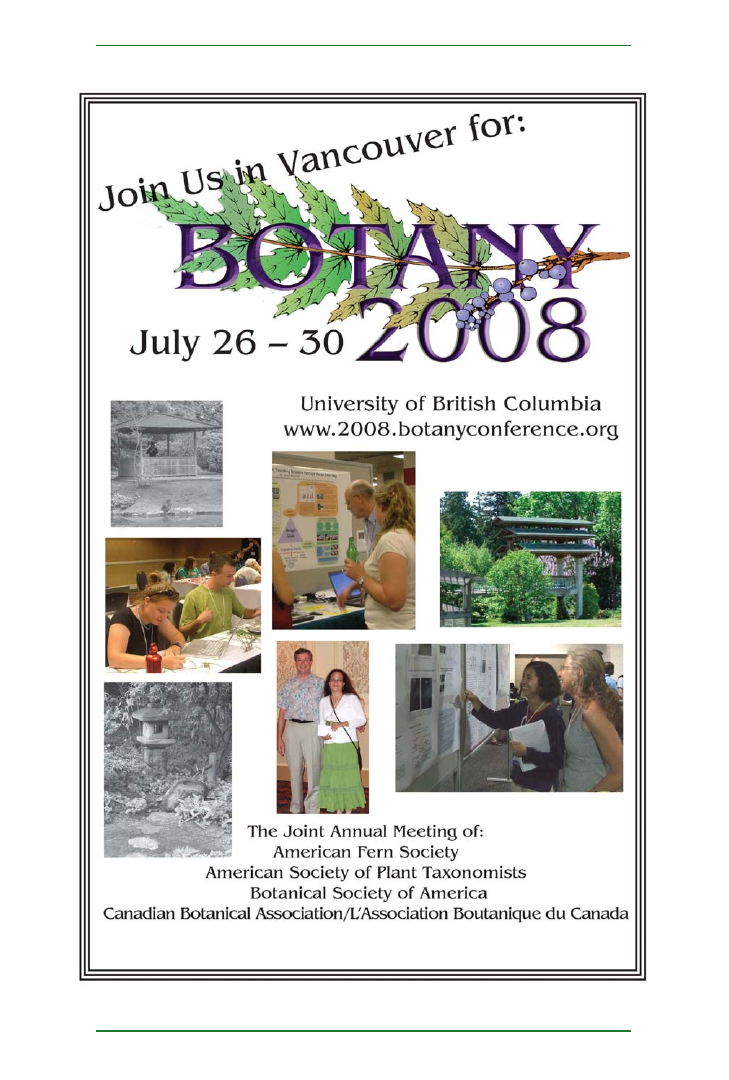
180
Plant Science Bulletin 53(4) 2007